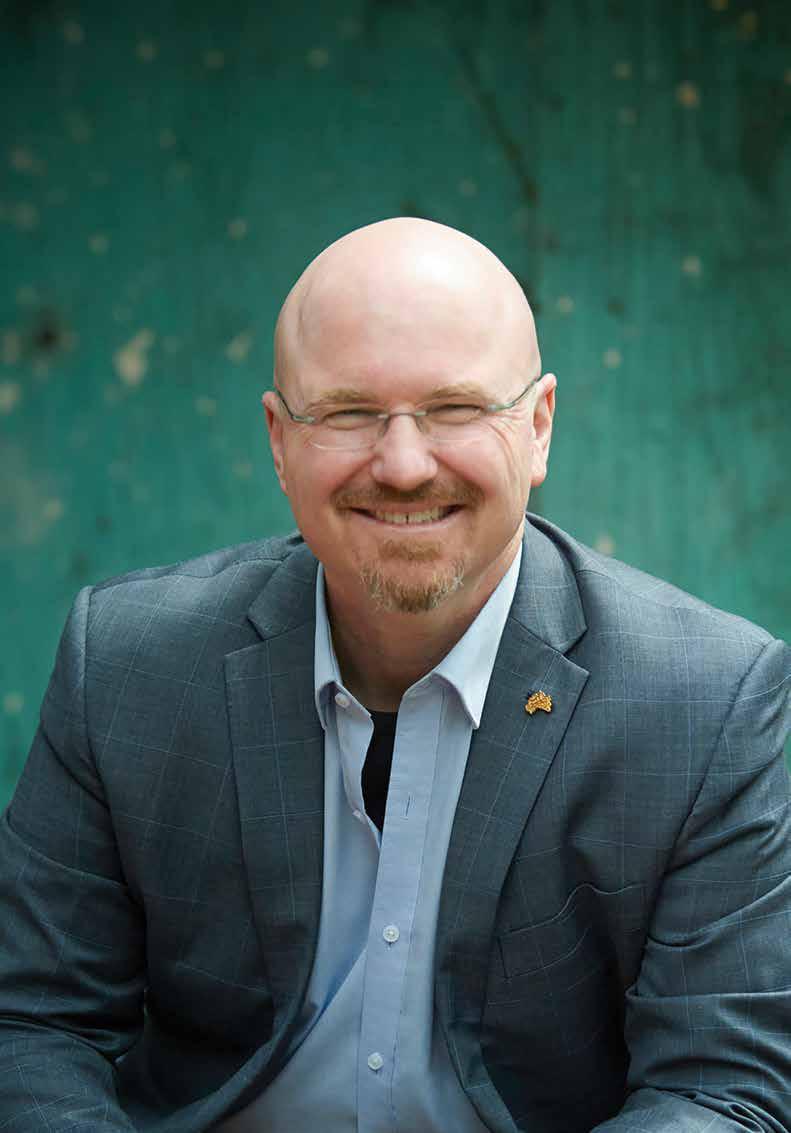
Tim Conolan AM WOMEN IN AMBULANCE Meet the 2024 Honour Recipients CAA CHAIR HOWARD WREN Celebrating 50 years in the ambulance sector ISSUE 15 | AUTUMN 2024 Founder and CEO of TLC for Kids, the man putting the TLC back into sick kids' lives www.caa.net.au
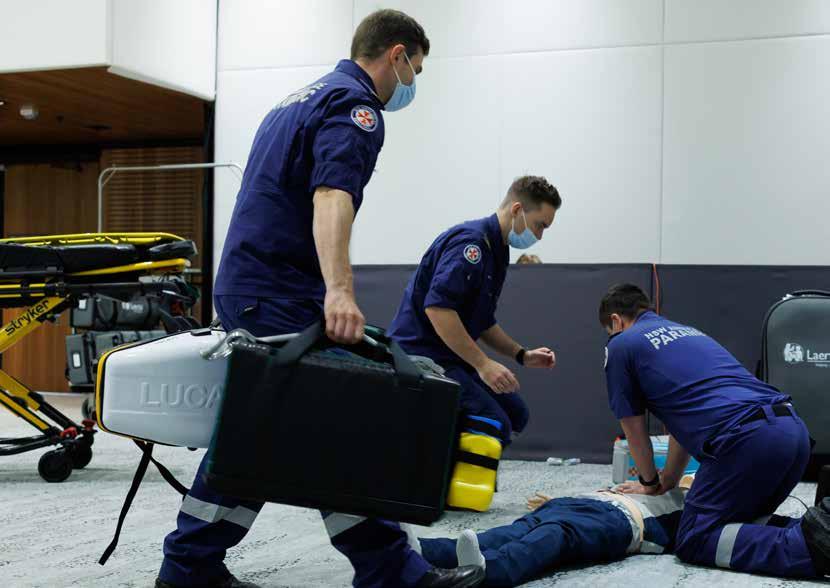

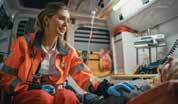


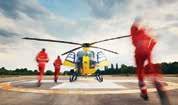

amPHI Mobile – Comprehensive ePCR used within the ambulance units.
amPHI Web – Live stream incident and patient information to receiving facilities.
amPHI Secondary Triage – Supports early initiation of the ePCR offering a documented decision of care pathway and allows responding ambulance units to have direct access to the information.
amPHI Special Events module – Unique collaborative web-based mass casualty management system.
amPHI is currently installed in more than 800 ambulance response units (road and air) with 15,000+ users, servicing over 9 million citizens. amPHI boasts a consistent uptime of more than 99.98% and is supported by 24/7 system surveillance.
amPHI’s™ Prehospital solution is a clinician designed complete digital care pathway that is secure, reliable, and resilient, from dispatch to hospital handover. The solution is scalable, and configurable to adapt to organisational
need and provides powerful data mining capability. amPHI’s ability to seamlessly stream information between response units and receiving care facilities supports true collaborative care.

data empowered clinicians making the right decisions at the right time supporting best patient care outcomes WELCOME TO amPHITM Life flows through our software The amPHI
Find out more: Contact us: info.anz@dedalus.com
Informed and
solution consists of:
JOIN US AT THE 2024 CAA CONGRESS Program announcedlearn more at caacongress.net.au MELBOURNE CONVENTION AND EXHIBITION CENTRE 14-16 AUGUST 2024
Dear friends & colleagues,
As we embrace the arrival of autumn, I am delighted to introduce you to the April issue of FIRST magazine.
In February we celebrated a remarkable milestone as one of our esteemed board members reached a significant 50-year anniversary in the Australian ambulance sector.
Howard Wren’s dedication and commitment has been instrumental in shaping the direction and success of not only the ACT Ambulance Service but indeed the whole Australasian ambulance sector, and we extend our heartfelt congratulations and gratitude for his invaluable contributions.
In this issue, we shine a spotlight on a true visionary and humanitarian, Tim Conolan, the founder of TLC for Kids. Through his unwavering passion and tireless efforts, Tim has transformed the lives of countless sick children, offering them hope, support, and relief during stressful and traumatic times. Join us as we learn more about his inspiring journey and the profound impact he continues to make in our community.
I am thrilled to announce the much-anticipated 2024 Women in Ambulance awards recipients. This initiative aims to honour and celebrate the outstanding women from across the Australasian ambulance services, recognising their dedication, professionalism, and leadership.
In addition to our featured stories, this issue delves into an important topic that affects women in the workplace: women's health and menopause. With increasing numbers of women navigating menopause while balancing their careers, it's essential to address the challenges they face and explore strategies for creating supportive and inclusive work environments. Join Karen Stewart from St John WA as she examines the impact of menopause on women's health and well-being and highlights practical solutions for promoting workplace wellness and empowerment.
As always, we are committed to bringing you engaging content that informs, inspires, and empowers. Thank you for your continued support, and we hope you enjoy the autumn issue of FIRST magazine.
With love,
 Mojca Bizjak-Mikic Editor-in-Chief FIRST magazine
Mojca Bizjak-Mikic Editor-in-Chief FIRST magazine

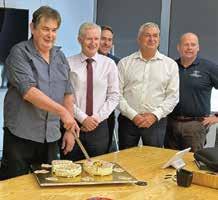
03 Letter from the Editor
06 Data First 2023 Ambulance Snapshot.
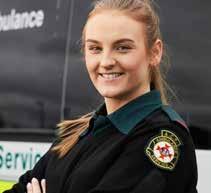
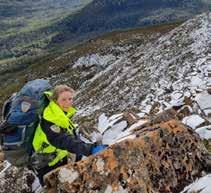
18 Focus First
The 2024 Women in Ambulance Awards - Celebrating Women’s Contributions in the Ambulance Services.
30 Opinion First
The challenges of navigating Perimenopause.
08 Industry First
Read the latest news from across the sector.
10 CAA First
A recap of the past quarter with the CAA including CAA Chair Howard Wren's 50 year celebration, Patient Experience Survey, Congress, the Women in Leadership Symposium and Hand Hygiene Day.
34 Services First
Showcasing the latest projects and achievements from across CAA member services.
42 Awards First
Meet all the recipients of the Ambulance Service Medal, and hear from the 2023 CAA Awards for Excellence Star Award winners about their efforts to manage shift patterns and fatigue.
Contents ISSUE 15 | AUTUMN 2024 10 18 34
4 www.caa.net.au
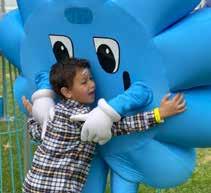
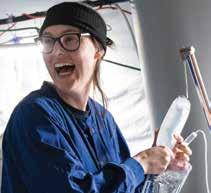

46 Feature First
FIRST speaks with Founder and CEO of TLC for Kids, Tim Conolan about the impact his charity is making for sick kids and their families.
56 Partners First
In this edition of FIRST we share articles from Belgravia eHealth, AFAC24, The Seasonal Bushfire Outlook for Autumn 2024, and the Australasian College of Paramedicine
67 Research First
Sharing the latest innovative research projects from around the ambulance world. 74
Sustainability
In this edition of FIRST, we take a look at promoting susainability in Ambulance Services..
76 People First
Meet just some of the wonderful people that make up the Australian Ambulance services.
78 The Directory
80 Wellness First
Approaching self-improvement with Mitch Mullooly.
THE TEAM
Editor: Mojca Bizjak-Mikic
Relationship and Content Manager: Georgie Leach
Editorial Team: Georgie Leach & Courtney Waters
Publication Design: Kade Marsh, Alpha State
PUBLISHED BY:
The Council Of Ambulance Authorities 2/141 Sir Donald Bradman Drive Hilton SA 5033 Australia admin@caa.net.au
Magazine published from paper that is sustainably sourced.
46 56 60
For article submissions or to advertise in FIRST by CAA magazine please contact admin@caa.net.au 5
Ambulance Snapshot

The CAA continued to collate data throughout 2023 from the Australian, New Zealand and Papua New Guinea statutory ambulance services.
The data collected is used for comparison benchmarking and is published across CAA platforms, The Australian Data collated by the CAA is provided to the Australian Government’s Productivity Commission Report on Government Services.
The full report is available to read at caa.net.au/report-on-government-services
Across Australia, New Zealand and Papua New Guinea in 2022-23 financial year:
Ambulance Stations and locations
1,865
All Salaried Staff
Ambulances and other vehicles
8,129
26,642
Aircraft (excludes New Zealand)
862
Volunteers and First Responders
10,463
Data First
6 www.caa.net.au
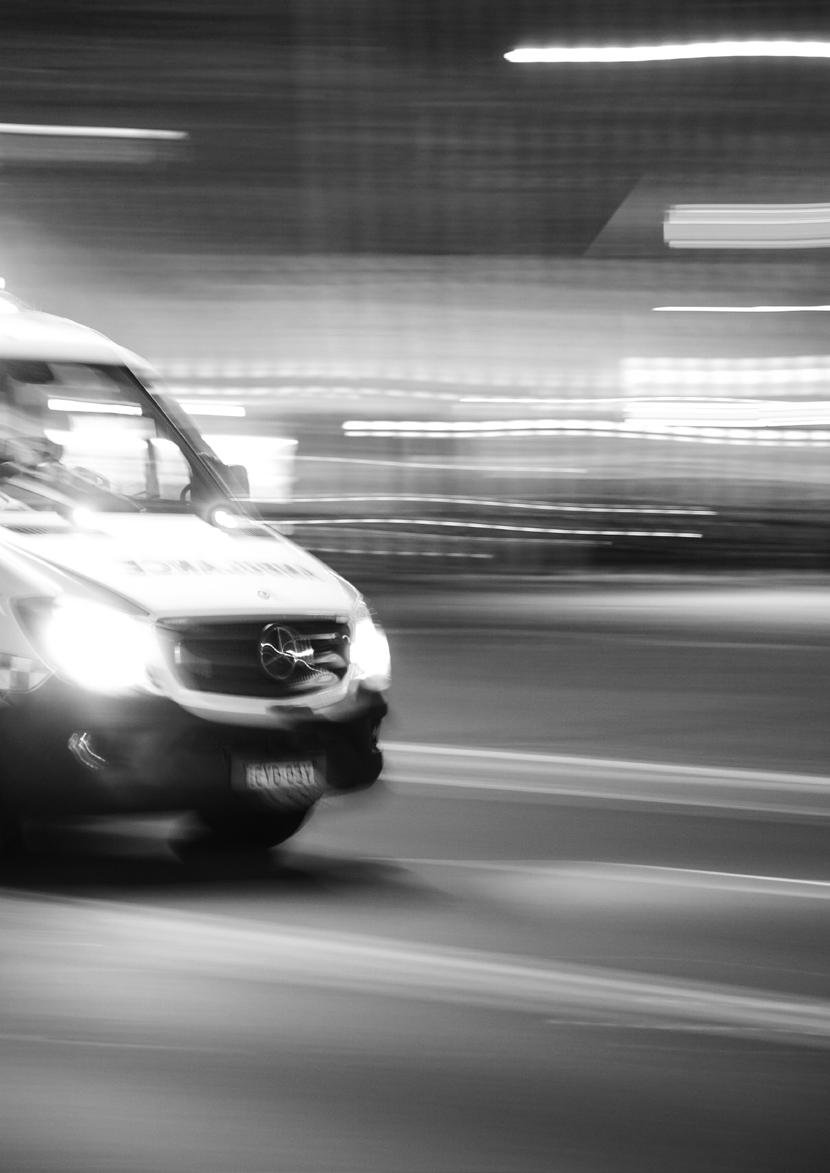
Incidents reported to ambulance service organisations
4.9 million
Responses where an ambulance was sent to an incident (excludes Papua New Guinea)
6.4 million
Calls made to 000 or 111 (excludes Papua New Guinea)
4.8 million
7
Industry News
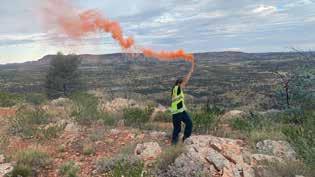
St John NT develops specialised Remote Area Access Training (RAAT) program
With the assistance of a Northern Territory Community Benefit Fund Grant, St John NT has developed the Remote Area Access Training (RAAT) program to deliver the standard of care needed when attending cases in remote areas and ensure the safety of all involved. The RAAT teaches hands-on, specific skills to perform remote rescue type operations and to deliver frontline health to people within austere environments.
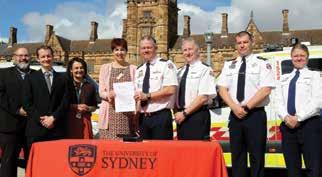
NSW Ambulance & University of Sydney partner for future
health workforce
NSW Ambulance and the University of Sydney have joined forces to collaborate on research and education to upskill NSW Ambulance paramedics, nurses, doctors and corporate staff. This inaugural partnership will provide further education and research opportunities for NSW Ambulance and the wider health workforce of the future. Tailor-made micro credentials, clinical and leadership courses, collaborative research and implementation science programs are some of the proposed benefits of this partnership.
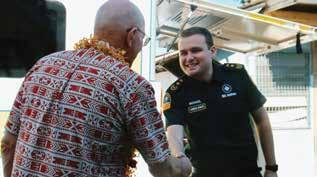
St John Solomon Islands gets a visit from the Governor General
His Excellency General the Honourable David Hurley AC DSC (Retd) recently visited the National Referral Hospital on their recent trip to Honiara, Solomon Islands to see first-hand the impact of the #SIAusPartnership for health. His excellency was pleased to see the the vital work of local staff, and how the donation of ambulances from Queensland Ambulance Service has made a real difference in accessing rural areas.
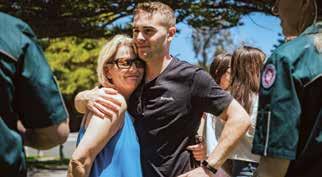
St John WA report finds that community defibrillators triples the chances of survival
A report produced by St John WA in association with the Pre-hospital, Resuscitation and Emergency Care Research Unit (PRECRU) at Curtin University has found that using community Automated External Defibrillators (AEDs) almost triples the chances of a Western Australian surviving an out-of-hospital cardiac arrest (OHCA). The 2022 OHCA Report also found that cardiac arrest patients who received a AED shock pre-ambulance had a 48% survival rate of up to 30 days post incident.
Industry First
www.caa.net.au 8
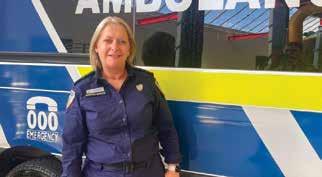
Ambulance Tasmania welcomes new Executive Director of Operations, Michelle Baxter
Ambulance Tasmania has welcomed a new recruit for the role of Executive of Operations, Michelle Baxter who has joined them from Queensland Ambulance Service in early February 2024. Michelle brings 30 years of valuable experience to Ambulance Tasmania as well as a passion for mentoring women. We congratulate Michelle and Ambulance Tasmania on the new appointment.

Hato Hone St John welcomes new Major Incident Support Team vehicle for Central Otago
The team at Hato Hone St John are proud to announce the latest piece of equipment to join them in Central Otago, the Major Incident Support Team (MIST) vehicle. Each MIST vehicle contains vital equipment to support frontline emergency ambulance teams, including bulk medical equipment capable of treating up to 50 patients, stretchers, an inflatable rescue shelter, a generator, scene lighting, and vital communications equipment.
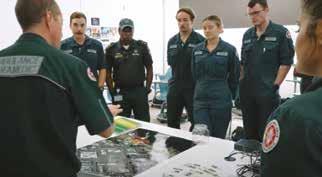
St John WA has welcomed six officers from St John Ambulance Papua New Guinea on a month-long exchange program with the goal of having both sides learn from each other. The officers immersed themselves in St John WA operations, exercises, and culture-building international connections and expertise as part of an Australian government-funded leadership development program.
PNG Exhange program at St John WA
9
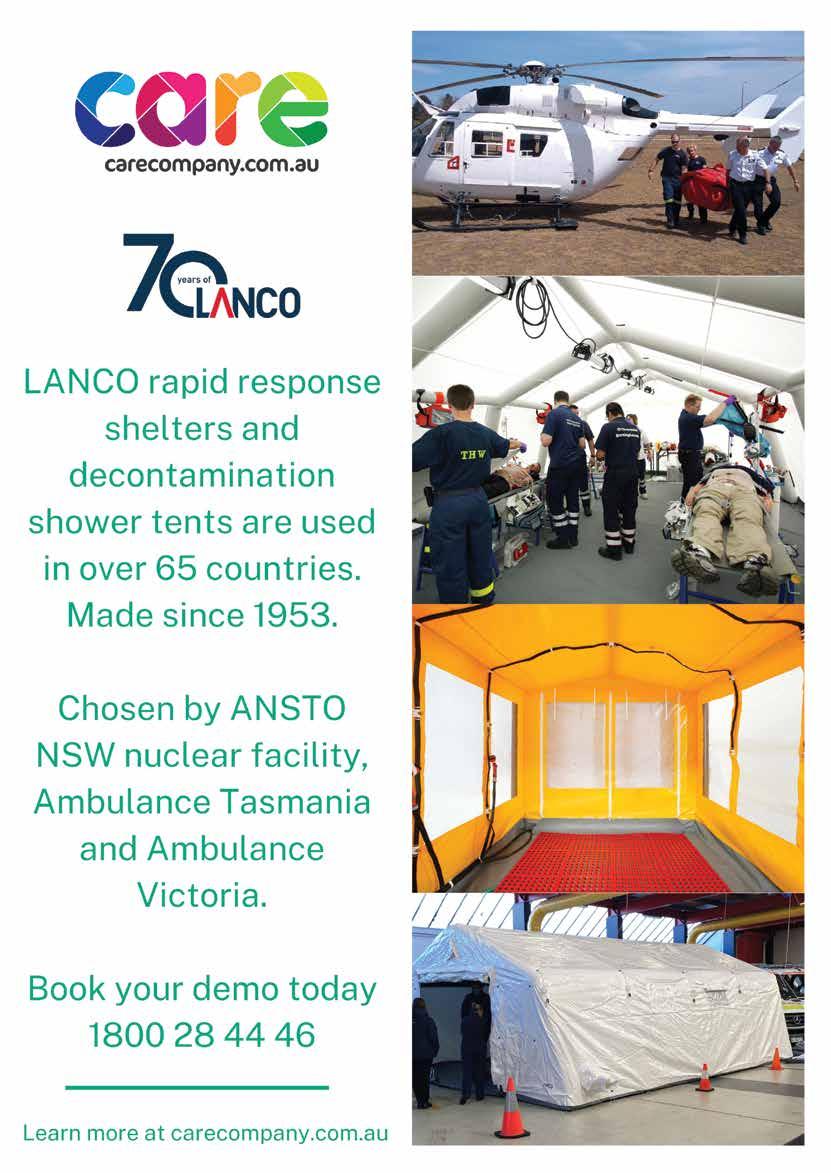
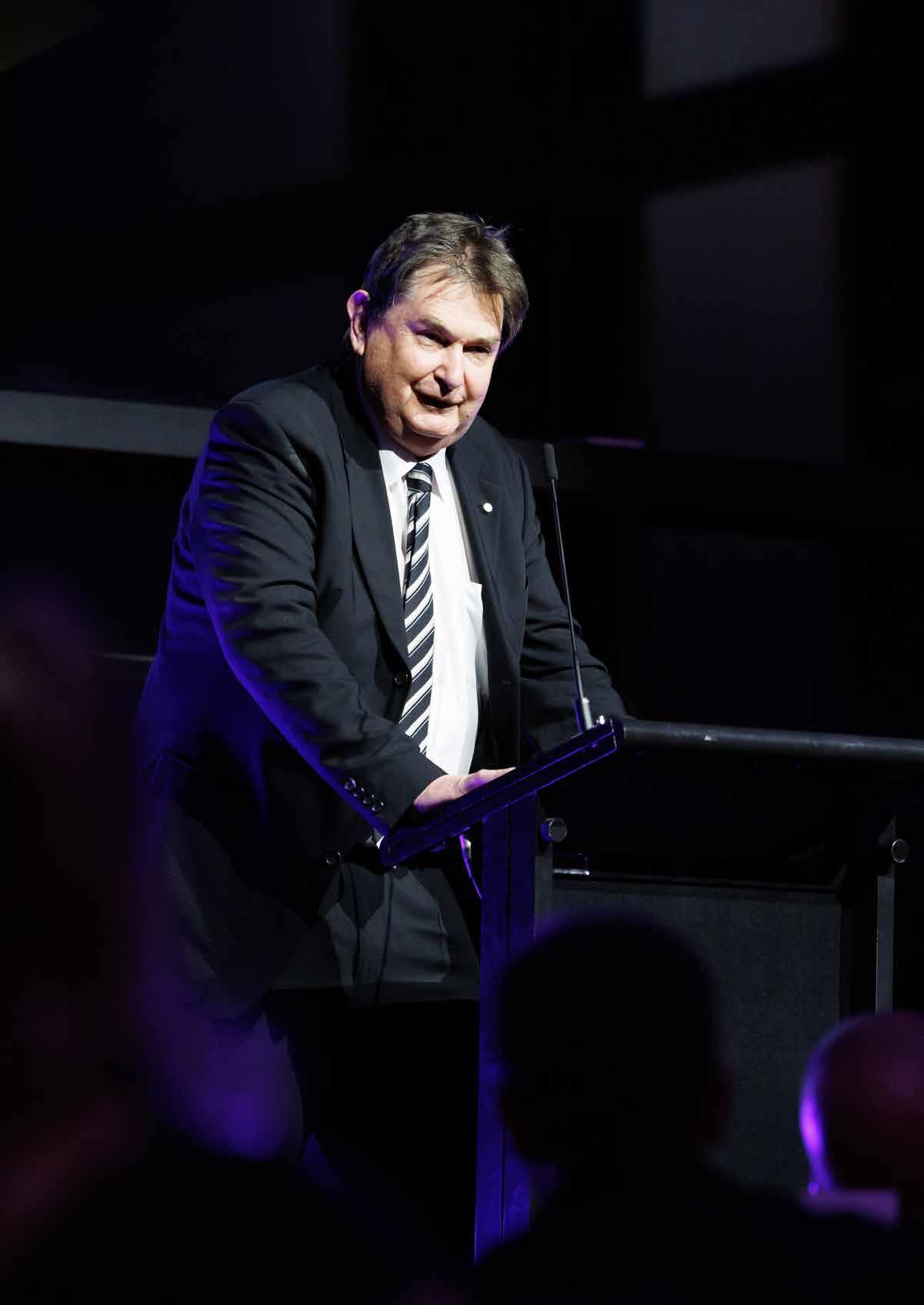
CAA Chair and Chief Officer for the ACT Ambulance Service, Howard Wren, is celebrating 50 years of service within the ambulance industry.
We spoke with Howard about his remarkable experience within the industry and his current tenure as CAA Chair.
CAA First 11
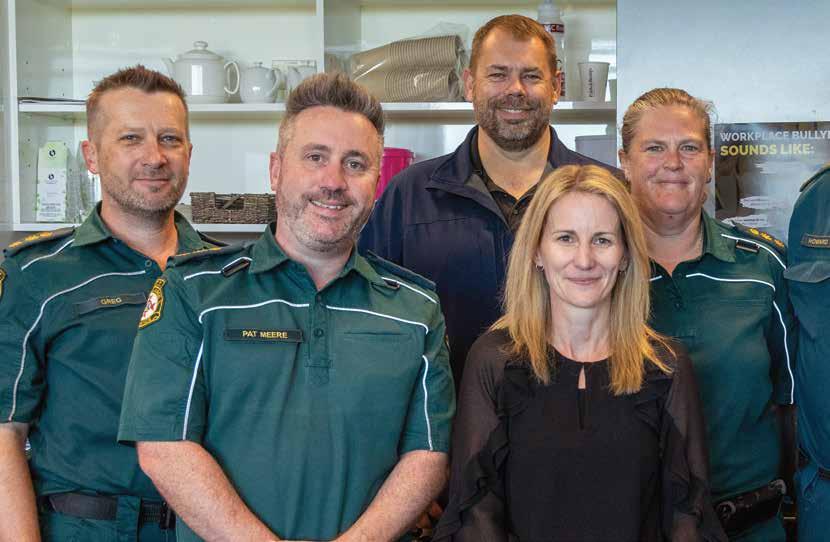
Howard, congratulations on your 50-year milestone service to the Ambulance Service here in Australia. Tell us how it feels to be working in the ambulance sector for almost 50 years?

Thank you. I’m astonished at the changes that have occurred – although across 50 years I guess change is to be expected. Certainly in 1974, I didn’t envisage paramedics (or ambulance officers as most of us were then) being registered health professionals with an entry level tertiary qualification.

Why did you decide to go into Paramedicine all those years ago? What was it that appealed to you?
I always had an interest in healthcare, and the variety of working in an ambulance service. Even in those days, in rural NSW, the local ambos were valued members of the community, and this appealed to me as well.


Being on the frontline, we all know there are some cases that just stick with you. What are some remarkable ‘human stories’ that you’ve lived with during your career?
For me, the stand-outs are the personal “firsts”. The first out-of-hospital delivery; the first cardiac arrest save; the first patient intubated. And the more challenging cases: first patient who died in front of you; first child cardiac arrest.
Tell us about some of the industry highlights you’ve seen during your 50 years?
There are probably two things I consider absolute highlights; defibrillation available on every frontline ambulance and now part of most firstresponder capability. This has been an absolute gamechanger and truly a life-saving intervention for countless patients since first implemented. And secondly, effective pain relief available to all patients. Patients in pain and discomfort are seen by most paramedics literally every day.
Compared to 50 years ago the analgesic options available now are truly amazing.
CAA First www.caa.net.au 12
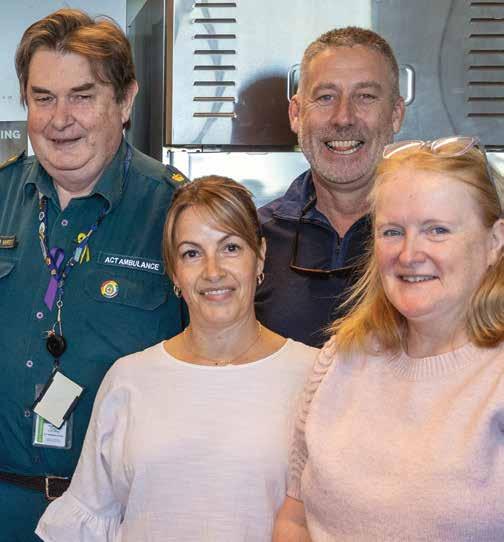
 Howard Wren
CAA Chair and Chief Officer for the ACT Ambulance Service
Howard Wren
CAA Chair and Chief Officer for the ACT Ambulance Service

Tell us about what it means to be the Chair for the CAA and what’s your role? What are you most proud of during your time as Chair with CAA?
It has been a privilege to serve as Chair of the CAA – although to be honest, as the selection process is not exactly merit-based, I have suffered somewhat from imposter syndrome on many occasions.
Over the past 2 years, CAA has faced some challenges. As Chair, my role in addressing these challenges has been minor – however there is a sense of achievement in being part of a wider team that has met these challenges and provided a path for the organisation to continue to develop.

What would you say to your former self starting out in the industry?
I would absolutely tell my former self to go ahead and start the journey. Embrace change, as uncomfortable as change sometimes is, and grab opportunities for learning and development.
This is truly an exciting time to be starting a paramedic career. The opportunities within the jurisdictional ambulance services, the private sector and academia are unparalleled and will only continue to evolve.
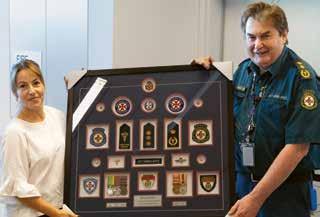

On behalf of the CAA, we thank Howard for his unwavering contribution and leadership during his tenure as Chair of the CAA. Howard will step down as Chair in August 2024.
13
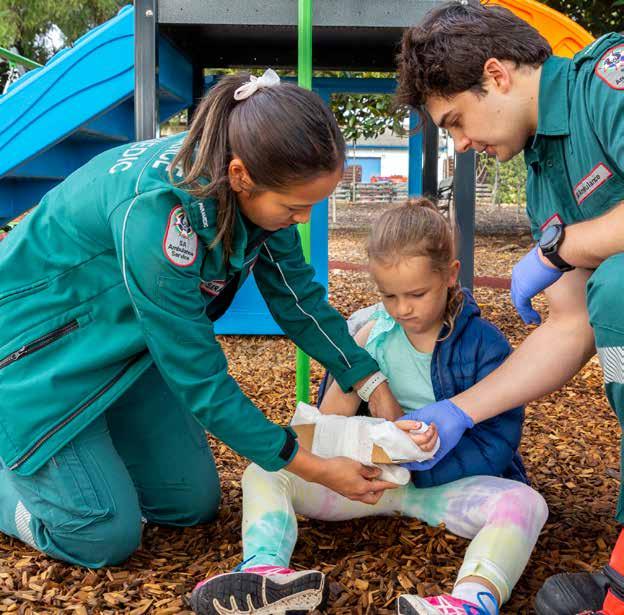
Learn more about what the Council of Ambulance Authorities have been working on within the first half of the year so far. With an incredible full year of events, campaigns and programs to come, it's one of the biggest years yet.

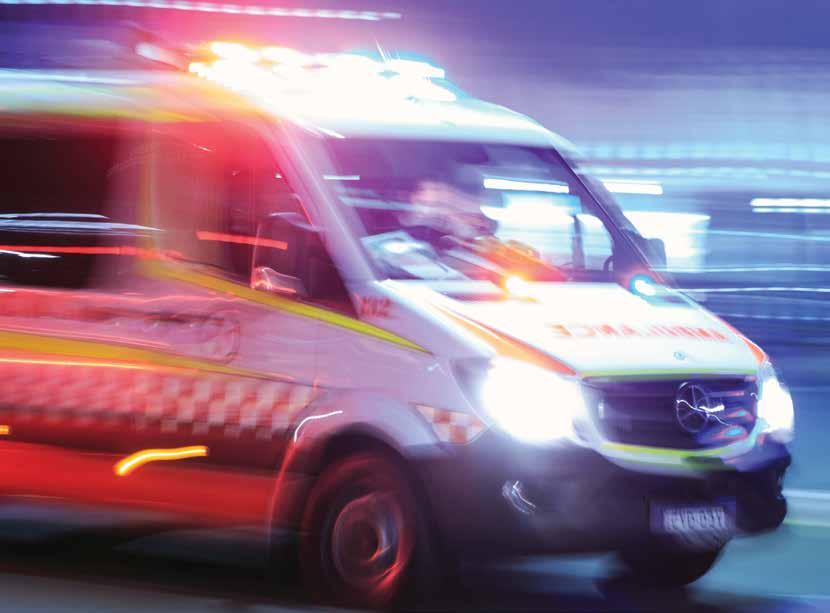
CAA Patient Experience Survey
Since 2002, 2007, and 2020 respectively, the CAA has conducted the Patient Experience Survey in Australia, New Zealand, and Papua New Guinea. This survey plays a crucial role in monitoring patient experiences to gauge the quality of ambulance services as reported by recent service users. Through gathering this valuable feedback, the CAA and it’s member organisations gain insight into recent experiences of treatment and care provided by the services, thereby identifying areas of service delivery that could benefit from enhancement.
The survey encompasses a comprehensive assessment, prompting patients or caregivers to rank their satisfaction with various aspects of ambulance services and treatment. Key areas evaluated include telephone assistance, timeliness of response, treatment received, competency of staff, journey comfort, and overall satisfaction.
CAA First 14 www.caa.net.au


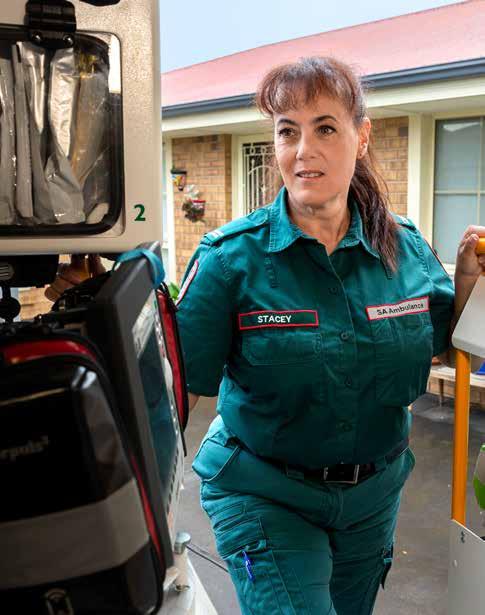
The survey methodology differs among the three regions: in Australia, it is conducted as a mailout: in New Zealand via SMS; and in Papua New Guinea, it takes place via telephone. The survey targets a sample of patients who have undergone emergency or urgent transportation by the respective services. Notably, data collection responsibilities rest with individual ambulance services in each jurisdiction, ensuring a thorough and region-specific evaluation of patient experiences.
Learn more: caa.net.au/patient-experience-survey
2024 Congress 14th - 16th August
We are thrilled to announce the 2024 Council of Ambulance Authorities (CAA) Congress will take place from August 14th to 16th at the prestigious Melbourne Convention & Exhibition Centre.
Prepare yourself for an extraordinary experience at the CAA Congress, renowned as the premier gathering in Australasia’s pre-hospital sector. It offers a unique platform for you to engage with and learn from top leaders and senior management teams in ambulance services, health, and emergency management across Australia, Papua New Guinea, and New Zealand.
Our Congress promises an action-packed expo, featuring the latest industry updates and innovations, alongside the highly esteemed CAA Awards for Excellence.
Learn more: caacongress.net.au
15
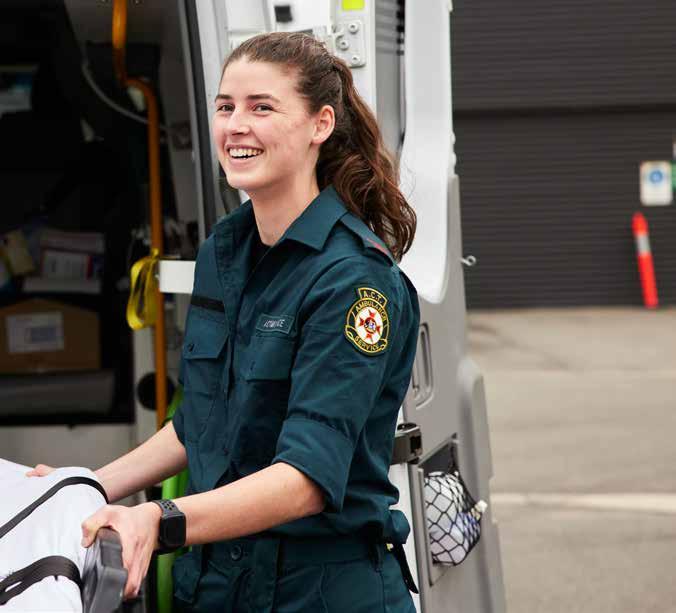

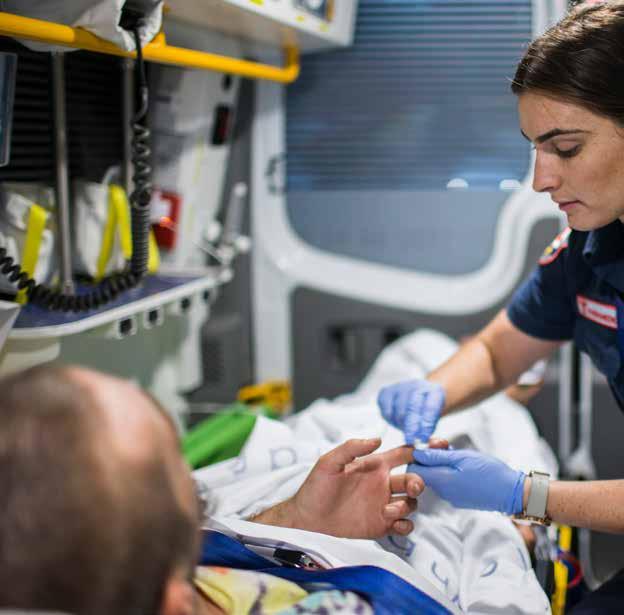
2024 Women in Leadership Symposium, 21st November
The Council of Ambulance Authorities recognises the importance of promoting women in leadership roles within the ambulance sector. To help address this, our annual Women in Leadership Symposium will be held in Sydney on 21st November to provide practical skills, tools, perspectives and takeaway tips to help women currently in leadership positions or those aspiring to take on such roles within the ambulance sector.
The event features accomplished speakers and leaders from the ambulance and emergency services industry who share their experiences and insights. Additionally, the symposium announces the winner of the annual Women in Leadership Scholarship, further supporting the advancement of women in this field.
By fostering networking opportunities, professional development, and learning from successful women leaders, the CAA's Women in Leadership Symposium plays a crucial role in empowering and inspiring women to excel in leadership within the ambulance sector.
To learn more about the symposium, please visit caa.net.au/symposium and stay tuned via our social for more updates.
CAA First 16 www.caa.net.au


Take 5 for Hand Hygiene
Take Five for Hand Hygiene is an annual campaign created by the Council of Ambulance Authorities to highlight the importance of hand hygiene during paramedic’s time with patients. The campaign is designed to highlight 5 key moments when dealing with patients and importantly speaks about good hand hygiene and the over-reliance on wearing gloves, that when not worn properly can assist in spreading contaminants.
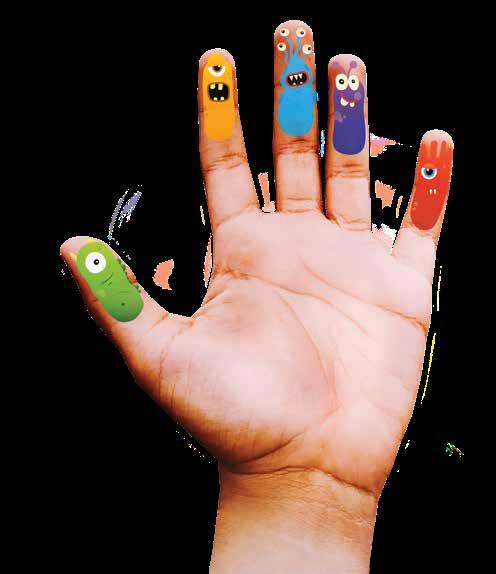
lead to death. Emergency medical workers, including paramedics who consistently encounter many patients every day, risk transmitting harmful microbes without properly sanitised hands. Contamination can occur from patient contact or via the environment in which the patient is being treated, including an ambulance.
The spread of infection can be stopped by complying with the five moments of hand hygiene before and after every patient encounter. The five steps will protect working paramedics, patients and the area of treatment form the spread of germs.
This year World Hand Hygiene Day will be held on May 5th.
Learn more: caa.net.au/take5
17
2024 CAA Women in Ambulance Awards
In celebration of the 2024 International Women’s Day and our steadfast commitment to a gender-equal world, free of bias and discrimination, we are thrilled to announce the recipients of our 2024 CAA Women in Ambulance Awards.
The 56 honour recipients represent the exceptional contributions of women across Australasian ambulance services, spotlighting their resilience, dedication, and leadership. Embracing diversity and inclusion, the awards embody progress and empowerment, amplifying the voices of those who champion equality within the sector.
NSW Ambulance

Belinda

From frontline paramedics to senior executives, this year’s honorees exemplify the ethos of #InspireInclusion, driving positive change and inspiring others to pursue their passions fearlessly.
Congratulations to all the Honour Recipients. To learn more about each of the 2024 CAA Women in Ambulance honour recipients, please visit caa.net.au/wia





Boothroyd Body Worn Camera (BWC) Project Manager 15 years service
Clare Richmond Pre-hospital and Retrieval Specialist, Director of Training, Aeromedical Operations 11 years service
Dr
Senior State Retrieval Consultant, Aeromedical Operations 17 years service Judith Butcher Duty Operations Centre Officer, Western Control Centre 23 years service Kha-Van Pennefather Deputy Director of Finance 10 years service Phoebe Wood Extended Care Paramedic (ECP) 10 years service
Dr Frances Miao
Focus First 18 www.caa.net.au







Queensland Ambulance Service












Brooke Rolfe Manager Clinical Education, Metro South Region 20 years service Christine Axelby Director, Employee and Industrial Relations 17 years service Hayley Salethorne Acting Assistant Commissioner 16 years service Lauretta Howarth Senior Operations, Supervisor, Far Northern Region 28 years service Natalie Schutt Specialist Pharmacist 8 years service Suzanne Nehring Acting Executive Manager, Rockhampton Operations Centre 15 years service Ambulance Victoria Belinda Delardes Ambulance Paramedic & Resuscitation Coordinator 7 years service Carina Gibson Acting Area Manager 20 years service Deb Bright Ambulance Community Officer - Team Leader 2 years service Emily Nehme Research Governance Manager 12 years service Jo Algie Team Manager 15 years service Rebecca Veitch Emergency Medical Response Educator 24 years service St John WA Belinda Marsh Volunteer Ambulance OfficerEmergency Medical Response 9 years service Karen Stewart Acting Head of Department - Country Ambulance Operations 12 years service Katy Aviles Area Manager 15 years service Lauren D’Arcy Ambulance Paramedic 11 years service Nicki Foster District Area Manager 13 years service Pamela Toyne Event Services Team Leader 21 years service 19
SA Ambulance Service













St John Ambulance Papua New Guinea




Ambulance Tasmania Anna Ekdahl Manager, Office of the Chief Executive 13 years service Cait Scaife Operations Supervisor 9 years service Carol Van Der Velde Volunteer Ambulance Officer 8 years service Kimberly Wessel Acting Operations Manager 3.5 years service Krysta Hansch Nurse Manager of Patient Transport & Interfacility Coordination 5 years service Margaret Chilcott Volunteer Ambulance Officer 12 years service
Dr Angela Martin Community Paramedic / Regional Team Leader 21 years service Belinda Amber SAAS MedSTAR Kids Nurse Consultant 14 years service Diane Sanders Manager, Technical Services 30 years service Elisabeth (Liz) Charles Service Development Manager 18 years service Olivia Delli Quadri Clinical Team Leader 18 years service Paula Parker Regional Team Leader 30 years service
Ambulance
Nicola Smith Ambulance Manager Clinical Governance 10 years service Sandra Nissen ComCen Quality Assurance Officer 12 years service Joddy Bolony Lead Pharmacist 3 years service Shirellyn Pielo Director - People, Workforce & Culture (PWC) 6 years service
ACT
Service
Focus First 20 www.caa.net.au
St John Ambulance Australia NT






Hato Hone St John

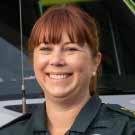




Wellington Free Ambulance





Angelina Butler Training Administration Officer 17 years service Erin MacZkowiack Clinical Dispatch Supervisor and Paramedic 15 years service Kim Szymanski Accounts Payable Officer 9 years service Mareesa Bates Paramedic 7 years service Renee Guesnon Paramedic 3 years service
Anna Pownall Area Operations Manager 9 years service Debra Larsen General Manager Ambulance OperationsHealth Services 3 years service Millie O’Grady Volunteer Support Manager 9 years service Pauline Buchanan St John District Operations Manager“Southland Otago” 54 years service Rachel Hallam Consumer ExperienceHealthcare, Manager 9 years service Sue Farquhar Payroll Manager 16 years service
Emily Regtien Emergency Medical Call Taker and Dispatcher 5 years service Jo Thompson Extended Care Paramedic 11 years service Kristy Cornwell Clinical Paramedic Advisor 9 years service Melissa WhitakerAtkins Operations Advisor 10 years service Rachel Evans Senior Heartbeat Coordinator 11 years service 21

Become a GoodSAM volunteer and receive alerts to help in nearby CPR emergencies while the paramedics are on the way. ambulance.nsw.gov.au/goodsam Help keep them alive, while paramedics arrive. Every minute counts. Sign up to GoodSAM.
Celebrating Women’s Contributions in the Ambulance Services
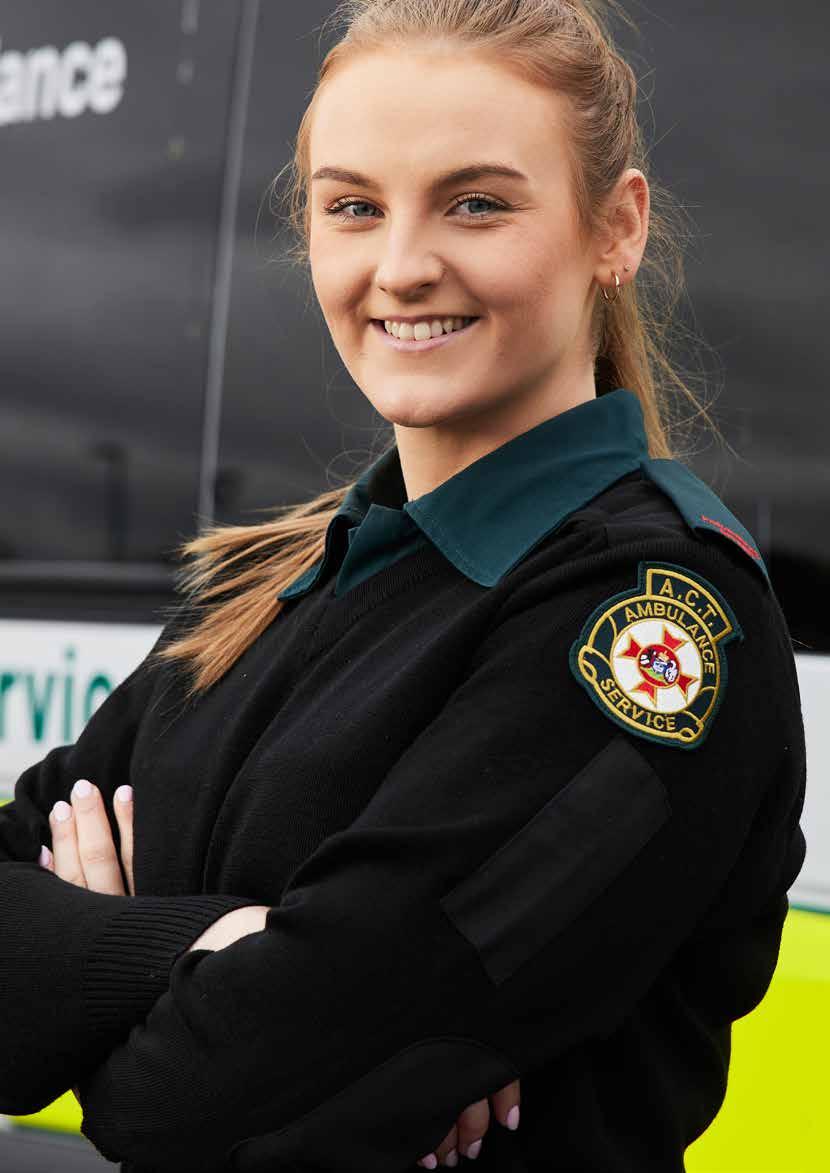
The ambulance workforce has traditionally been male-dominated, but times are changing.
Focus First

Women
now represent 42.5% of ambulance staff across Australasia, and their contributions are being celebrated more than ever.
In 2018, the CAA established the CAA Women in Leadership working group to provide a forum for women leaders in the ambulance sector. The goal was to provide an opportunity to exchange knowledge and effect positive changes within the sector across Australia, New Zealand and Papua New Guinea. Today, we are thrilled women within our sector are celebrated all year long with initiatives such as the Women in Ambulance Awards, Women in Leadership Symposium and the continued month-long work with the Women in Leadership working group.
As the ambulance services continue to evolve, the contributions of women will become increasingly vital. This year’s honorees exemplify the ethos of #InspireInclusion, making significant strides in advancing women’s equality within the ambulance services. From frontline paramedics to senior executives, their unwavering commitment to excellence and advocacy has propelled positive change and inspired countless others to pursue careers in this field.
The CAA Women in Ambulance Awards are not just about celebrating individual achievements; they also aim to empower and inspire future generations of women to step into ambulance careers and progress into leadership roles. In a world where diversity, equity, and inclusion are paramount, these awards embody the spirit of progress and empowerment.
To celebrate the 2024 Women in Ambulance Awards, the CAA spoke to the honour recipients to learn more about what keeps them motivated and inspired. We’ve collated responses here to give you a picture of our dynamic and diverse state members.
Focus First 24 www.caa.net.au

What inspired you to pursue a career in the ambulance sector?
“I joined St Johns as a Cadet at 11 years of age after my hearingimpaired best friend asked me to do a Home Nursing course with her, as her support person. I am forever grateful to her for what was the start of a tremendous career. I have had the privilege of seeing the ambulance world evolve into what it is today. We are in an industry that has advanced to become professionals in the health system, it is so gratifying to be able to be part of the advancements over the years. I have been fortunate enough to have been able to keep developing my ambulance craft along the way and I believe this is what makes it such a dynamic sector to be involved in. There are always challenges and new things to learn.”
Paula Parker, SA Ambulance Service
“I volunteered for our local Community Emergency Response Team (CERT) and after completing my first call out, I knew this was something I wanted to do as a new career.”
Jo Algie, Ambulance Victoria
“Following the terrorist attack in USA on the World Trade Centre, I decided that I wanted to help people who were experiencing a traumatic event/incident and I wanted to be able to offer practical help. This eventually led me to complete my degree in Paramedicine as a mature student (10 years on). After spending some time volunteering on a frontline ambulance, and due to my young children, a role with the Patient Safety and Quality team became available providing information for the Coroner and Health and Disability Commission. My passion for helping people became about providing closure and answers for patients and whanau following a traumatic incident.”
Rachel Hallam, Hato Hone St John
“I joined the ambulance service as an emergency doctor, to provide high level critical care for patients, bridging the gap between where they are and the hospital, particularly for rural and regional patients. I enjoy the challenge of the intersection of clinical, logistical and human factors that pre-hospital and retrieval medicine provides - whether I am working on a vehicle, in the sky or on the phone in coordination.”
Clare Richmond, NSW Ambulance
“In 2019 I signed up as a GoodSAM Responder in my small community of Clunes. Over a short period of time I responded to several alerts within my community. In late 2021 I heard about the role of Ambulance Community Officer and a branch being set up in Clunes and made an application. I’m proud to serve my community as an ACO and GoodSAM Responder. Clunes is a small rural community, however over the last few years it has been recognised as a Heart Safe Community and boasts 13 AEDs, five of which are publicly accessible 24 hours a day.”
Deb Bright, Ambulance Victoria
“I joined NSWA in 2001 after completing a certificate in Counselling and was looking for a career where I could contribute and make a difference.. I’ve since gone onto roles of DOCO in the Western Control Centre and Local Lead for Peer Support Officers ( Western Sector) which have both exceeded my expectations . I’m proud to be here and truly love my job.”
Judith Butcher, NSW Ambulance
“I never planned to have a career within the Ambulance sector however my journey began as an 11yr old, in a small rural town where my Mum was a volunteer with the local St John Ambulance and to keep me occupied, she encouraged me to join the St John Youth movement. This saw my “passion for ambulance” take hold and literally a career spanning many years and many roles evolved. I was eager to be a part of the move to improving outcomes for patients and improving the skills and knowledge of our people.”
Pauline Buchanan, Hato Hone St John
“I’ve always been interested in pursuing a career in healthcare and caring for people. I started my time volunteering while I studied nursing, the exposure through volunteering steered me to the BHSc in Paramedicine. It was the diverse environment, being out in the community and camaraderie that really stood out to me.”
Mel Whittaker-Atkins, Wellington Free Ambulance
“I always had a caring, curious nature seeking connection to help others and personally saw just how vital access to healthcare is in changing peoples lives. After attending an open day for ambulance services in England I was committed to help bring advanced healthcare to our communities.”
Hayley Salethorne, Queensland Ambulance Service
25
Who do you consider your most influential role model?
“Throughout my journey as a young woman, I’ve been fortunate to have been guided and inspired by many influential individuals, from my parents to mentors in my early career. However, one figure who particularly resonated with me on my leadership path, especially in recent years, is Maya Angelou. Her poignant quote, “People will forget what you said and people will forget what you did, but they will never forget how you made them feel,” has deeply influenced my approach to leadership and interactions with others. It’s a sentiment I’ve instilled in my daughters from a young age, emphasising the importance of treating others the way they would like to be treated.
Interestingly, my most influential role models today are my own daughters, now aged 20 and 24. As they navigate their own journeys into adulthood, I find myself continually learning from them, seeking their contemporary insights to support my own growth in our rapidly changing world. In return, I strive to be the best possible role model for them, embodying the values of compassion, resilience, and continuous learning. This active exchange of wisdom and support between generations is a testament to the power of mentorship and the continuing impact of positive relationships.”
Karen Stewart, St John WA
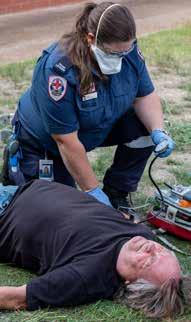
“I have had some fantastic role models over the years. When I first began work in the Clinical Governance Unit, Dr. Carol Shipp was the general manager. Carol always encouraged me to take on tasks that challenged me and this has been influential in my development as a Clinical Governance Manager.”
Nicola Smith, ACT Ambulance Services.
”My Mum is a significant role model in my life – working and raising a family, prior to going back to university and completing a law degree as a mature age student, practising family law, mediation and indigenous mediation right across Australia, along with sitting on numerous boards.”
Carina Gibson, Ambulance Victoria
“I know this is about International Women’s Day but I have to say that Dr Gary Tall has been a constant retrieval role model for my whole career. When I first started, there were no females in leadership in retrieval medicine. I was one of the first women to take on a role in education and governance for the early retrieval service. Gary was supportive and encouraging throughout, allowing me flexible work hours well before that was a thing! His dedication and work in developing retrieval into its current form is inspirational.”
Dr Frances Miao, NSW Ambulance
“Without a doubt that would be my Nan. She was born in outback Goondiwindi in the 1930’s and moved to Sydney by herself as a teenager to establish a career. She’s one of the strongest people I know and always has time to give me some well-considered advice. Just 37 years ago there were no Women in Ambulance in Victoria and I’m grateful for the women before me who made this such an accessible career path.”
Belinda Delardes, Ambulance Victoria
“My parents remain my foremost role models. Despite their limited education, they instilled values that have shaped my life profoundly. From a young age, they taught me the importance of love for God, honesty, respect, and going the extra mile in completing assigned tasks and also that education and learning never stops.”
Joddy Bolony, St John Papua New Guinea
Focus First 26 www.caa.net.au
What does this award mean to you?
“I am not comfortable being singled out or praised for my efforts however I believe that visibility provides normality to those who don’t see themselves represented. I am a full-time working family member who manages multiple challenges at home trying to do my best efforts at work, this does not always seem manageable and I don’t always feel successful so this award is about reminding everyone that we are all doing our best no matter what our personal circumstances are.”
Liz Charles, SA Ambulance Service
“I am honoured to receive this award. There are many inspirational women working in the ambulance field who deserve recognition and I am please to see the work that I have been doing on our First Nations inclusion project recognised publicly.”
Nicola Smith, ACT Ambulance Service.
“It is incredibly special to be recognised with this award as a female leader and pioneer of community paramedicine in the Australian ambulance sector. This award represents over two decades of my dedication to advancing the profession which would not have been possible without the ongoing support of my husband and family.”
Angela Martin, SA Ambulance Service
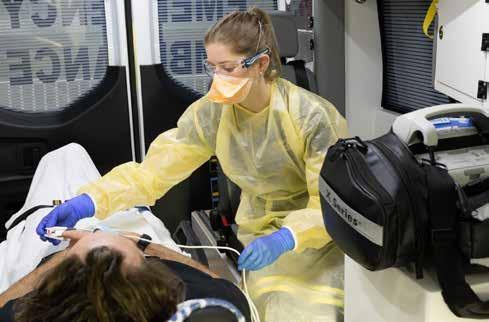
“Receiving this award I am humbled that my colleagues felt fit to nominate me a I carry out my everyday duties. I don’t think I am any more special than the other women volunteers and paramedics in Tasmania.”
Margaret Chilcott, Ambulance Tasmania
“I am deeply honoured to be acknowledged alongside the remarkable women within the Ambulance services. It fills me with pride to know that I can serve as an inspiration to women starting their careers and those seeking to embark on new journeys within ambulance - there are meaningful roles after time on-road”
Belinda Boothroyd, NSW Ambulance
“I encourage people to learn about the Operations Centres in Australasia; learn what we do and learn about our people. A lot of the time we are hidden away within the Ambulance Services, and I personally think we need to open the doors to encourage people learn what amazing people EMD’s are. We are the first point of contact when someone is asking for help - EMD’s do such an amazing job which does not always get the recognition it deserves. I will admit that we laugh, we cry, and sometimes we get angry about the hopelessness of a situation, but no matter what happens we always take a breath and pick up the next phone call ready to help!”
Suzanne Nehring, Queensland Ambulance Service
“Knowledge that the role I play is important to SAAS and the team I manage / lead is a credit to the organisation. Recognition of the progression of my career from the tradesperson to manager I have become.”
Diane Sanders, SA Ambulance Service
27

What motivates or inspires you? Do you have any inspirational quotes you’d be comfortable sharing?
"A friend once said to me: 'A 26 mile marathon starts with one step.’”
Sandra Nissen, ACT Ambulance Service.
“What motivates me the most is to strive to make a positive difference in what I do and with the people I work with. I don’t really have any inspirational quotes but there are a couple of value sets I hold: always strive to do the best that you can, always strive to do the right thing, regardless of the situation and always treat other people with compassion and how you would expect to be treated.”
Christine Axelby, Queensland Ambulance Service

“I am motivated by the patients and families, being part of a specialised team and promoting Women in retrieval and leadership roles. Step out of your comfort zone, acknowledge people’s abilities around you and role model for the next ones in line.”
Belinda Amber, SA Ambulance Service
“I have two favourite quotes. When I am feeling a bit flat and/or overwhelmed I refer to Theodore Roosevelt “Do what you can, with what you’ve got, where you are”, and otherwise I remember the exceptional Helen Keller’s quote “Life is either a daring adventure or nothing”.
Rebecca Veitch, Ambulance Victoria
“I’m not one for inspirational quotes but there’s a poem from Rupi Kaur called 'Progress' I’m obsessed with; Olivia Delli Quadri, SA Ambulance Service
Our work should equip the next generation of women to outdo us in every field. This is the legacy we’ll leave behind.”
'Progress',
by Rupi Kaur
Focus First
28 www.caa.net.au

WE SEE YOU ADVANCE

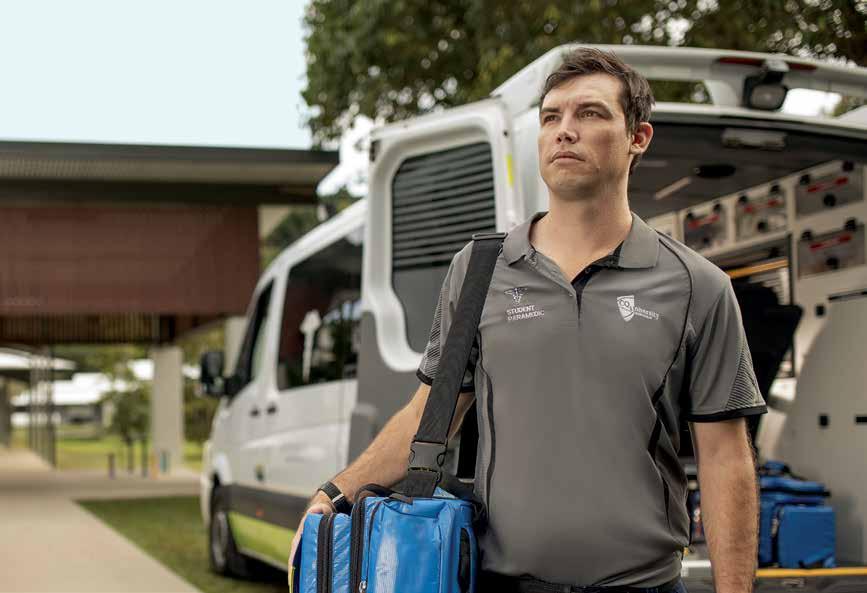
EXPAND YOUR SKILLS WITH POSTGRAD PARAMEDIC SCIENCE
Expand your knowledge and skills into advanced elds with a postgraduate quali cation in paramedicine from CQUniversity. With a graduate diploma or masters in Paramedic Science (Critical Care Practice), you can gain skills in dealing with complex environments and clinical leadership. Or study our Master of Paramedic Science (Primary Health Care Practice) to enhance and develop your leadership skills and clinical reasoning to provide essential services in non-emergency, out-of-hospital, low acuity or primary health settings.
Offered online via our renowned distance education mode, our postgraduate paramedicine courses allow you to pursue your career goals around your lifestyle and commitments.
APPLY NOW TO START IN MARCH
ACCESSIBLE, FLEXIBLE STUDY
Study online with con dence in our 40 years of distance education experience, plus access to facilities and support at 20+ national locations.
#1 IN AUSTRALIA*
We’re ranked #1 in Australia for postgraduate full-time employment rates, three years after graduation. * QILT Graduate Outcomes Survey – Longitudinal 2022
CRICOS: 00219C | TEQSA: PRV12073 | RTO: 40939
C_AD_2302_CAA_210x297_ParaMed

Navigating Perimenopause
by Karen Stewart Head of Country Ambulance (A/S), St John WA
Turning the age of 50 and navigating perimenopause in a predominantly male-oriented workforce poses distinct challenges.
Having spent the last three decades in ambulance services, I’ve witnessed positive changes but have also encountered some real challenges, and when it comes to women’s health, menstrual cycles, and the less-discussed aspects of perimenopause, menopause, and postmenopause these challenges are an issue that certainly require focus and education.
Therefore what, if anything in ambulance services, do we do to help and support our team members both in the frontline, and in our support roles experiencing these symptoms in women’s health.
As a young woman I was educated about puberty, pregnancy, and childbirth yet there was minimal guidance on the natural transition that accompanies the cessation of menstruation.
Traditionally 50 to 100 years ago, many women were at the end of their life span when they made this medical transition to menopause in their forties and fifties. However, with increased life expectancy, women now undergo this transition when they may be at the peak of their careers. Unfortunately, the stigma surrounding menopause persists, with 70% of women feeling uncomfortable discussing it in professional settings.
30 www.caa.net.au
Opinion First
Life expectancy is increasing
Today postmenstrual life is approx. 40% of your whole life
Postmenopause
Pre & Perimenopause
Menopause
https://www.ons.gov.uk/peoplepopulationaandcommunity/birthsdeathsandmarriages/deaths/articles/mortalityinenglandandwales/2012-12-17
Using
Perimenopause can span from four to ten years, menopause itself lasts only one day, occurring 12 months post the last period, and post-menopause encompasses the remainder of a woman’s life. Addressing these challenges within the ambulance services is crucial to support frontline and support role team members effectively.
The typical age for menopause is considered to be around 51 years old. It’s important to recognize that many women start encountering symptoms associated with perimenopause in their 20s, 30s, and 40s. Unfortunately, a significant number of these symptoms often go undiagnosed due to a lack of education and specialised healthcare providers in menopause symptoms.
It’s crucial to acknowledge the diverse experiences women undergo during this life phase. Approximately one-third of women may have minimal symptoms, while another third deal with life-altering and debilitating symptoms. The remaining third experiences a varied response, emphasising the unique and individual nature of each woman’s journey through perimenopause, menopause, and post-menopause.
The lack of awareness and understanding of these symptoms presents a challenge, and addressing this gap in education and healthcare resources is essential. Women report a variety of factors during this time, contributing to the complexity of their experiences.
During menopause, women face an increased risk of anxiety, depression, and suicide, with Australian women aged between 45 to 55 being particularly vulnerable to suicide, and over 70% of women reporting heightened stress and anxiety during this period. A concerning trend is the widespread prescription of anti-depressants as the first line agent by their GPs, indicating a gap in addressing menopausal symptoms. The effects of menopause touch on 100% of the population in one way or another, and the stigma in the workforce is felt by women on a regular basis.
In a 2023 study on women’s health in Victoria, around 30% of participants reported being affected by perimenopause or menopause symptoms. Women shared experiences of fatigue and cognitive difficulties impacting their work and daily life. Some struggled to access Hormone Replacement Therapy due to hesitancy from healthcare providers. One woman stated “I have struggled to access Menopausal hormone Therapy and other medications related to perimenopause due to my doctor’s hesitancy to discuss these issues with me. Instead, I have been prescribed antidepressants.”
1922 20 yrs (26%) 38 yrs (43%) 77 yrs 89 yrs 2022
modal age at death 1922/77 yrs 2022/89 yrs; Menopause 1922 57yrs, 2022 51 yrs; postmenopauseal life 1922 26%/20 yrs, 2022 43%/38 yrs
31
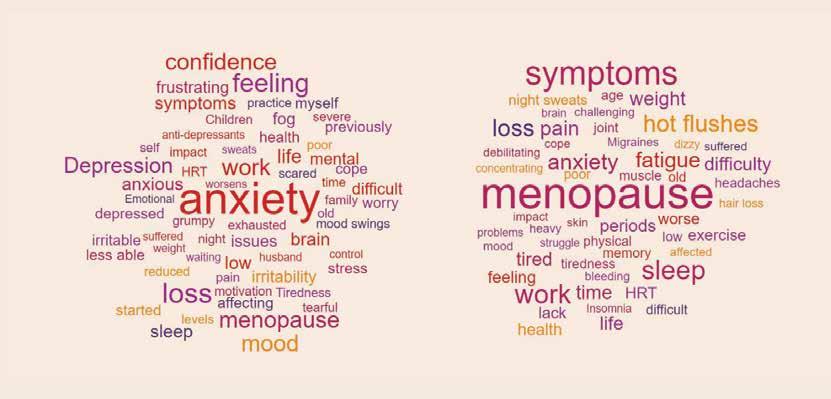
In the ambulance setting, physical symptoms can significantly affect work capability, compounded by uniforms often not designed for women, particularly those experiencing such symptoms.
In my workplace in 2023, I began to try and raise awareness for this underrepresented and under supported medical condition, The stigma is supported by situations and statements such as these.
I was asked by one senior manager not to talk about it as it made us look like a feminist movement and workplaces had managed fine until now.
One female manager said she would “be happy to support the cause as she had many older ladies in her department, I of course am nowhere near that age, but it’ll help me understand them better”.
Another lady said that she would lie about feeling unwell because her anxiety was so bad that she couldn’t face work but couldn’t talk to her manager so would say she had a cold or gastro rather than have the conversation around her actual menopause symptoms because she didn’t feel like they would understand or support her.
Promotion of gender equity, and proactive measures are essential to allow us to help support women and workplaces, in my opinion we need to support this collectively in Ambulance Services by:
Raised Awareness: Promote awareness about menopause as a natural medical condition affecting all women. Share information on symptoms, impacts, and available support.
Educate our Ambulance Services: Provide education to workplaces on the challenges women face during menopause. This includes the physical and emotional aspects and their potential impact on work performance.
Accreditation in Ambulance Services: Advocate for accreditation in Australian Ambulance Services to ensure comprehensive support for women on the frontline and in support departments. Follow the positive examples set by organisations like Boots the Chemist and The Thames Valley Police in the United Kingdom.
Address Uniform Design: Work towards uniform designs that consider the physical symptoms women may experience during menopause, ensuring comfort and functionality. Provide easy access to personal hygiene products for individuals.
Encourage Open Conversations: Foster an environment where open discussions about menopause are encouraged. Addressing the stigma requires breaking down barriers and creating a supportive workplace culture.
Provide Resources: Provide appropriate resources and information about menopause and make them readily available in the workplace. This can include informational sessions, pamphlets, and access to support networks.
By implementing these measures, we can contribute to creating workplaces that recognise and support women going through menopause, fostering gender equity and well-being.
32 www.caa.net.au

Additional information and reading can be found in these links here.
Australasian Menopause Society Website for an AMS registered doctor in your area here: menopause.org.au/health-info/find-an-ams-doctor
BBC UK bbc.com/news/av/health-43705088
Davina McCall freeview.com.au/watch-tv/shows/20db7787-5c89-40ac884e-caa87d7b32dc
Menopause Friendly Australia Menopause accreditation menopausefriendly.au/wp-content/ uploads/2023/05/Menopause-Friendly-Australia.mp4
Menopause Friendly Australia menopausefriendly.au/
Thames Valley Police and Boots UK on their journey to being award winning menopause friendly employers. menopausefriendly.au/wp-content/uploads/2023/05/ Menopause-Friendly-Australia.mp4
Victoria Government
premier.vic.gov.au/gender-pain-gap-revealed-andwomen-arent-surprised
engage.vic.gov.au/lets-talk-about-improving-womenshealth-in-victoria

Karen Stewart Head of Country Ambulance (A/S), St John WA
Karen graduated as the youngest female paramedic in Scotland in 1997 with an IHCD in Paramedicine, she completed 19 years in the Scottish Ambulance Service in various clinical and leadership roles before emigrating to Australia in 2012. In 2010 Karen undertook a Bachelor of Science degree which she completed in 2012. In that same year Karen joined St John WA initially as a paramedic before securing the role of Clinical Governance Operations manager. Since then, Karen has held senior positions including Acting Head of Clinical Services, and is currently Head of Department for Regional Operations.
In January 2021 Karen completed a Master’s in healthcare management through Murdoch University, during this study she undertook a research project which focused on the transition from clinical to manager from a paramedic’s experience. This research was published in the Australasian Journal of Paramedicine in January 2021. Karen is an Associate fellow with the College of Health Service Management and a certified health manager.
33

Emergency care in the wilderness – the paramedics who help patients out in the Tasmanian landscape
Ambulance Tasmania
Acall for help is received from a couple and their one-year-old baby stuck on Tasmania’s popular Overland Track due to a cold front that brought a sudden blizzard and icy conditions.
Luckily for them, the training and specialised role of search and rescue from Ambulance Tasmania came to the rescue. The family sets up their tent and shelters inside it – too scared to attempt the slippery walk toward the carpark.
They set off an emergency beacon and shortly after, a search and rescue crew arrive with Jess Lea from Ambulance Tasmania to assist.
“I recall the icy wind was stinging my face and not being able to see more than a couple of metres in front of me.
“They were so unbelievably relieved when we got to them. I remember that we placed the little baby down the front of one of the police officer’s thick jackets where they stayed nice and warm and slept the whole way along the trek back down to the car park.
Services First
34 www.caa.net.au
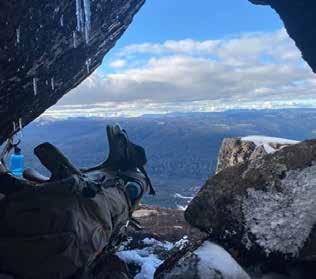
“When we got to the bottom the couple were incredibly grateful for our assistance and were clearly very pleased that the ordeal was over and that they were all safe. It is the sheer gratitude on people’s faces when they see you that makes this job really rewarding.” said Jess.
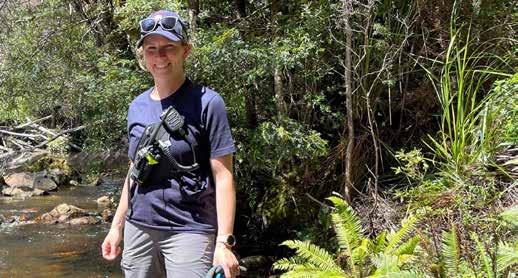
Manager of Ambulance Tasmania’s Emergency Management and Special Operations unit, Simon Harmsen, says Wilderness Paramedics perform a critical role as part of Ambulance Tasmania.
“Our Wilderness Paramedics are
“Carry clothing to cater for every possible season – yes four seasons in one day is definitely a thing in Tassie!” Jess Lee, Ambulance Tasmania.
Jess is an Ambulance Tasmania Intensive Care Flight Paramedic (ICFP). She is also a trained Wilderness Paramedic – a specialised role that involves assisting search and rescue cases and providing immediate medical care to patients who have been missing and/or injured in remote areas inaccessible by road or helicopters. Common areas in Tasmania for these types of incidents include the Western Arthurs, Mount Wellington, Cradle Mountain and Franklin River –all popular tourist and exploration spots.
“Those that are out bushwalking are by far the most common we attend but it could be anything from mountain biking, rock climbing, white-water rafting, kayaking, caving, canyoning, paragliding, fossicking to fly fishing – just to name a few!” Jess said.
really honed into that skill that is required to navigate, know the area, understand the austere environment that they’re going into. There are no limits to where our Wilderness Paramedics can go,” Simon said.
“Wilderness Paramedics are an integral part of our ambulance service. Tasmania’s beautiful environment will always attract many visitors and I don’t believe that will ever change,” Jess said.
Fully qualified Paramedics with at least two years’ experience can apply to be trained as Wilderness Paramedics (all ICFPs are required to undertake the training). Two training blocks are undertaken every year in winter and summer – running mock scenarios to test skills and equipment out in the environments they’ll be expected to venture into on real cases.
“The training is designed to ensure that every Wilderness Paramedic has the core skills required to not only find and look after people in the wilderness environment, but also be able to comfortably look after yourself as well,” Jess said.
“We look at the history that they’re bringing to the service so a lot of Paramedics who apply have a background in outdoor education or they do a lot of guide walking and rock climbing,” Simon said.
Wilderness Paramedics are based in each region of Tasmania (south, north and north west) and are ready to be seconded off-road from their usual Paramedic shifts to help people stuck in the wilderness. If you are preparing to travel to Tasmania to check out the sights and explore the beautiful wilderness, there are a few things to remember to stay safe.
“Always be prepared even if you’re going for a day walk. Take equipment including appropriate shelter if the weather conditions change, food, water, and an emergency position-indicating radiobeacon (EPIRB) as well to call for help,” Simon said.
Jess Lea, Intensive Care Flight Paramedic, Ambulance Tasmania
35
Photos courtesy of the Tasmanian Department of Health

Treating Elderly Patients with Dementia
36 www.caa.net.au
Queensland Ambulance Service
M ost developed countries have defined older people to be over the age of 65.
This cohort represents the fastest growing segment of the Australian population and consequently older patients are an increasing proportion of work for ambulance services. Older patients now live longer with chronic and often incurable conditions and their health management will commonly require a degree of both medical and social care.
The assessment of an older patient is often more complex than one conducted in younger patients as it focuses on individuals with complex or chronic conditions such as dementia and emphasises the patient’s functional status and quality of life.
Dementia is a clinical syndrome that can be caused by several underlying diseases, including Alzheimer’s. Although dementia can occur at any age, it is far more prevalent in older people. Approximately 9% of people over the age of 65, and 30% of people aged over 85 have a diagnosis of dementia.
People with dementia are entitled to the same legal rights and ethical considerations as any other person. Health professional must keep the following points n mind when interacting with a person with dementia:
• Valid informed consent should always be sought from the person with dementia for health care decisions. If the person lacks the capacity to make a decision, the relevant state law in respect of substitute decision making for health matters must be followed.
• Information provided by the person with dementia should be treated in a confidential manner. Confidential information should only be disclosed without the person’s consent in exceptional circumstances, e.g. where the clinician has a duty of care.
Health professionals should provide a person-centred care, by identifying and responding to individual needs and preferences of the person with dementia, their care(s) and family. Talk to the patient and don’t prejudge their level of understanding.
Health professionals should use language that is consistent with the ‘talk to me’ good communication guide for talking to people with dementia:
Make eye contact and speak clearly in short sentences, avoid jargon
Use clear and simple language and use repetition if required, but sensitively.
Avoid patronising, treat the patient with respect and dignity.
Use empathy, don’t minimise the patient’s feelings.
Try to avoid distractions to help keep their focus.
Be patient and allow plenty of time for them to respond to questions.
Provide information in small chunks.
Caring for the older patient can present a challenge for the clinician as assessment needs to consider the patient’s physical and mental state, medications and social circumstances which may complicate the management of an otherwise simple ailment. Clinicians need to maintain a high index of suspicion that seemingly uncomplicated signs and symptoms can be the manifestation of serious underlying pathology.
37
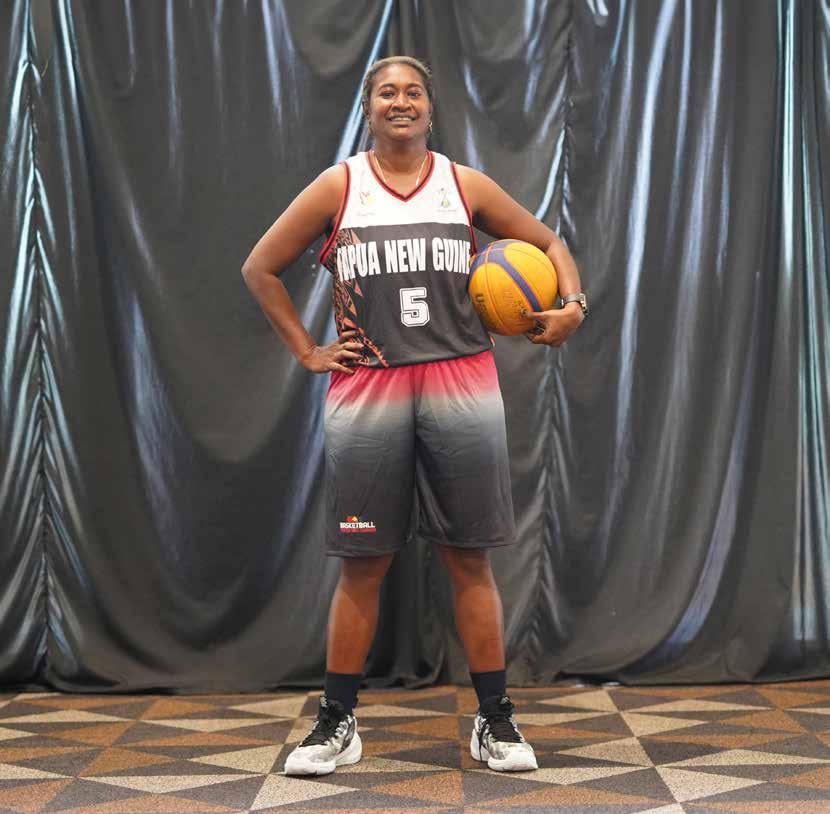
Leading PNG 3x3 Women’s Basketball Team to 17th Pacific Games
St John Ambulance Services Papua New Guinea
St John Ambulance’s Ronnie Pomat Returns to Court
38 www.caa.net.au Services First
Ronnie Pomat, a devoted member of the St John Ambulance team, proudly represented Papua New Guinea (PNG) in Senior Women's 3x3 Basketball, serving as captain during the 17th Pacific Games held in Honiara, Solomon Islands in 2023.
Ronnie is the Chief of Staff to the CEO and has been with the ambulance service since 2018. Her journey to make the team is a testament to her exceptional skills, work ethic, and commitment to both her role at St John Ambulance and her passion for basketball.
Having commenced her basketball journey in her youth, Ronnie's return to representing PNG on the international stage was a remarkable feat, echoing her prior achievements as a Bronze Medallist at the South Pacific Games in Samoa in 2007.
Her appointment as captain by the Papua New Guinea Basketball Federation not only recognises her prowess on the court but also highlights her leadership qualities and dedication to the sport and her profession.
According to Head Coach Nick Daroa, Ronnie’s inclusion was a significant morale boost for the team as the team needed an experienced leader.
Beyond her athletic accomplishments, Ronnie's role as a leader and captain exemplifies her as a role model, drawing from her professional expertise to inspire both her team and the wider community.
“The team eagerly anticipates Ronnie’s leadership and contributions in any future roles and responsibilities that may be entrusted to her,” concluded coach Nick.
Reflecting on her journey, Ronnie acknowledges the rigorous demands of the 3x3 basketball format and credits her fitness regimen and commitment to training for her successful return to the sport after a 15-year hiatus.
My commitment to the SJA staff fitness training program and engaging in recreational basketball and sports have kept me fit and in shape that when I was called to join the train-on squad it was easy for me.”
Ronnie Pomat, Chief of Staff to the CEO, St John Ambulance Papua New Guinea
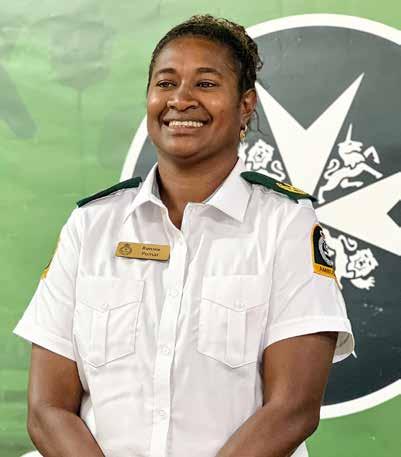
“To make the team one has to be at the peak level of fitness." says Ronnie.
“Commitment and dedication to training made it happen for me.
She extends her gratitude to St John management and staff, the Basketball Federation of Papua New Guinea, her family, and the community for their unwavering support.
Her story stands as a beacon of inspiration, embodying the idea that with determination and hard work, one can truly excel in multiple arenas of life.
Ronnie’s journey is not just her own; it is a source of inspiration for aspiring athletes and individuals seeking to make a positive impact in both their professional and personal lives.
39
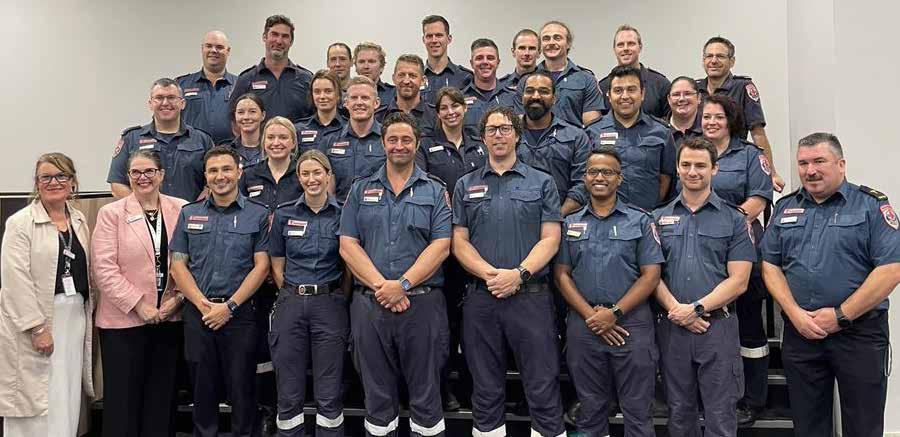
Record cohort of new intensive care paramedics
Ambulance Victoria
The largest-ever cohort of new Mobile Intensive Care Ambulance (MICA) paramedics in Ambulance Victoria’s (AV) history is just days away from starting on-road.
Twenty-nine Advanced Life Support (ALS) paramedics have graduated from the MICA Bridging Program, and commence on-road training alongside fully qualified MICA paramedics. AV Director Operational Capability
Trevor Weston said the new MICA interns were a significant boost for critical care across the state.
“Demand for our highly skilled MICA paramedics is increasing and it is important we continue to meet the needs of the growing Victorian community,”
Mr Weston said.
“We currently have 580 MICA paramedics, and by the end of 2024, we will increase our MICA workforce by about 14 per cent.
“We are confident this next generation of MICA paramedics will make an enormous contribution to our delivery of world-class care to patients across Victoria.”
MICA paramedics have a higher clinical skill set than ALS paramedics and can perform advanced medical procedures including advanced airway management, administer intra osseous (into bone) medication, and provide advanced management of cardiac conditions.
Fourteen MICA interns will hit the road in metropolitan Melbourne and 15 in regional Victoria, including branches in Campbellfield, Rosebud, Frankston, Hampton Park, Tarneit, Ravenhall, Ringwood East, Bundoora, Bendigo, Geelong, Morwell, Ballarat, Wangaratta, Wodonga and Shepparton.
Services First
40 www.caa.net.au
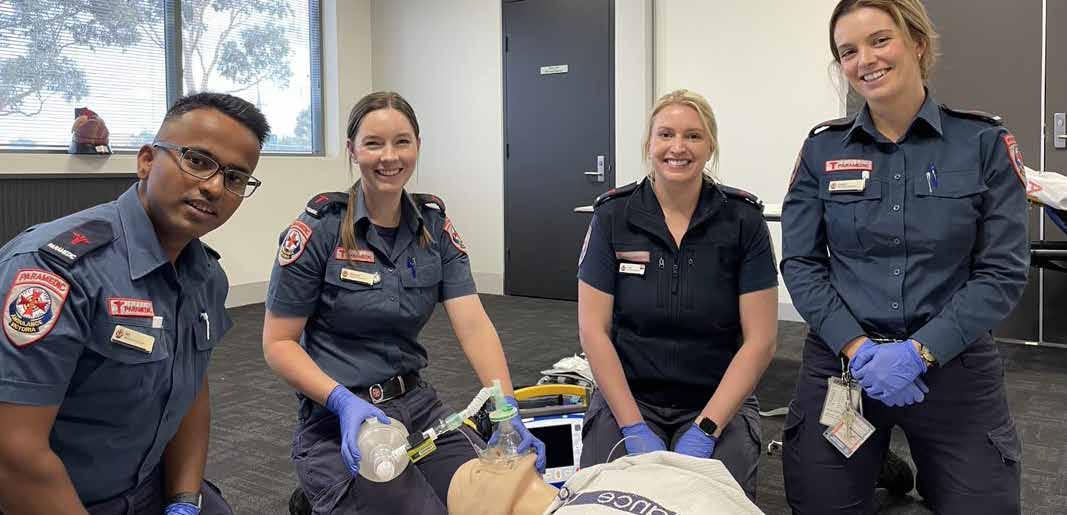
We are confident this next generation of MICA paramedics will make an enormous contribution to our delivery of world-class care to patients across Victoria.”
Trevor Weston, Ambulance Victoria Director Operational Capability
Growing up just outside Shepparton, Paramedic, Chenaye Bentley, has spent most of her career working in the region and is looking forward to applying her intensive care skills on-road moving forward .
“The course has been amazing, and I can’t believe the development we’ve all had,” Chenaye said.
“I’m excited for this next stage and know I’ll be incredibly supported by the MICA paramedics I’ve been lucky enough to work with over the last seven years.”
Wij Gunarathne, who worked as a cardiac nurse in Melbourne hospitals before joining AV, said he’s looking forward to providing patients an advanced level of care.
“With my cardiac skillset I thought I would be well suited to MICA and I was lucky to have a lot of support from my AV colleagues who encouraged me,” Wij said.
“I’m very excited to start on road and put everything we’ve learned over the last six weeks into practice.”
A further 50 ALS paramedics are planned to undertake the MICA Bridging Program throughout the year, with about 80 new MICA interns on road by the end of 2024.
The six-week program, held at AV’s Capability Hub in Sunshine, covers a range of clinical areas including respiratory, cardiac, trauma, medical, paediatric and obstetrics.
“Our MICA paramedics have a reputation as being among the best in the world and, therefore, our MICA interns must have access to the best training facilities and expertise,” Mr Weston said.
“We congratulate this cohort on their achievements to date and wish them all the best for this next stage in their AV career.”
Enrolment into the AV MICA Bridging Program occurs after successful completion of the Graduate Diploma of Specialist Paramedic Practice at Monash University or an equivalent qualification.
41
(L-R): Mobile Intensive Care Ambulance (MICA) interns Wij, Chenaye, Eliza, and Jordan.
Ambulance Service Medal in the Australia Day Honour Roll
In January this year, the prestigious award for the Ambulance Service Medal (ASM) was announced by the Governer General nationally, recognising distinguished members of an Australian ambulance service.
The CAA congratulates the following recipients who were recognised in the 2024 Australia Day Honours List.
Ambulance Victoria

Lindsay Bent Clinical Lead Communications Centres

Barry Curtain
Team Manager Bendigo

Lindsay Mackay

Director Operational Triage Services, (Recently A/ Executive Director Operational Communications) Ian Walsh Ambulance Community Officer in Charlton





Alan Wilkins Ambulance Community Officer in Paynesville
Awards First
ASM State Duty Manager Ruth Hutchinson ASM Ambulance Officer Peter McEntee ASM Area Clinical Team Leader Michael John Holland OAM Ambulance Officer
SA Ambulance Service Andrew Albury
42 www.caa.net.au
St John WA

Melissa Gardier
Ambulance Paramedic

John Backo
Transport Team Leader
Ambulance Tasmania

Suzie Smith
Volunteer Ambulance Officer

Dane Hendry
Country Manager – State Operations Centre

Paul Beech
Emergency Medical Technician
NSW Ambulance

Brian White
Assistant Commissioner/ Director
Metropolitan Clinical Operations

Marty Nichols
Associate Director Paramedicine & Clinical Practice

Kay Armstrong Inspector/ Duty Operations Manager
St John NT

Kylie Killalea ASM
Paramedic and Area Manager of Katherine
Queensland Ambulance Service

Kevin Homer
Advanced Care Paramedic

Erin Saltmarsh
Senior Operations Supervisor
43

2023 CAA Awards for Excellence Star Award Winner
Review of Shift Pattern and Fatigue at Wellington Free Ambulance
Join us as we speak with the team from Wellington Free Ambulance who are responsible for creating the award-winning submission on the topic of shift patterns and fatigue.
Can you please provide us a recap on your project, Review of Shift Pattern and Fatigue at Wellington Free Ambulance.
The need to better manage fatigue across the frontline teams was identified as a key priority at Wellington Free Ambulance in 2022. There was an understanding and appreciation of the challenges of shift work and a willingness to look at options for different ways to structure the 24/7 shift cover required of an emergency ambulance service.
Since the project was established significant work has gone into reviewing, analysing, and discussing potential solutions through the Shift Pattern Review Project. This included carrying out a desktop fatigue study with a sleep expert to identify the shift pattern that could potentially have the most positive impact on staff fatigue and wellbeing, conducting a pilot of the 3on/3off shift pattern in late 2022, reviewing and analysing the results of the pilot, as well as conducting workshops with staff - both from the road and operational support teams.
Following the successful pilot of the 3/3 it was decided to move forward towards an implementation with this shift pattern option for all Wellington based EAS staff. A day vehicle shift pattern was also identified as another option that would be offered to staff as part of the implementation phase.
What was the initial aim when beginning this project?
To establish what options could be possible and the potential benefits of different shift pattern configurations all to achieve more socially supportive conditions and reduce fatigue among staff. The initial aim of our work was to desk top options and work towards piloting an option that would support fatigue management as well as being suitable for organisational capability and capacity.
Awards First
44 www.caa.net.au
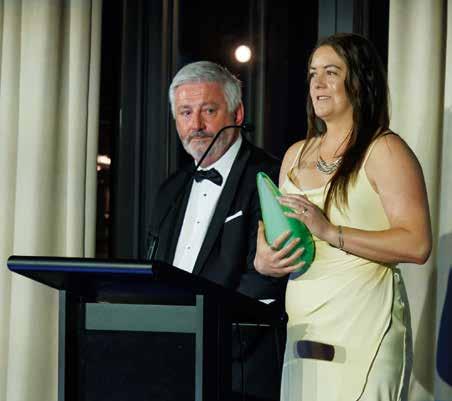
What are the end goals for the project at Wellington Free Ambulance?
Reduce fatigue, improve conditions for staff, provide socially supportive options for all staff across WFA. Establish an evidence-based shift pattern option built pilot feedback and analysis and work towards rolling out across existing staff. The current roll out of shift pattern options is available to current EAS staff and this will extend to other teams and new staff once embedded in organisational processes.
What are the collateral benefits of a project like this?
Staff have options, they can consider their personal circumstances and preferred working style when indicating a shift pattern that works for them. Offering options indicates to staff that their health and wellbeing is a priority for Wellington Free Ambulance, this is a benefit to current staff and future staff. We have also noted the considerable interest from staff returning from parental leave who wish to have regular hours to be able to create work life balance with family commitments.
From a response perspective Wellington Free Ambulance the shift pattern options creates the ability to cater for demand, resultin in crews being on the road to meet the community demand with staggered start and finish times. The implementation of a day vehicle also increased the response capability during the busy daytime hours, with less run on’s into the evening and night shift.
Wellington Free Ambulance
Wellington Free Ambulance is the first ambulance service in Australasia to offer shift pattern options across frontline crews. This includes the day shift vehicle which is a core part of base fleet and the soon to be established 3:3 option. The 3:3 being offered is also unique in that it includes two 12 hour days – with one early and one late start plus one ten hour night shift.
Looking at the future, what is the next step for the Review of Shift Pattern and Fatigue at Wellington Free Ambulance?
Wellington Free Ambulance is currently well into the planned implementation of the shift pattern options work. During October and November 2023 WFA introduced a day vehicle to the base fleet. WFA currently has the capability to run up to four day vehicles across each day of the week. 11 staff have made the move to this shift pattern with another two anticipated to join in the near future.
Expressions of interest for staff wishing to move to a 3:3 shift pattern has seen 16 people progress towards a shift pattern change indicate. We anticipate having 1 ambulance per at each shift start time per day, working alongside the 4:4 shift pattern going forward at launch in April 2024.
Following the April implementation attention with move to making shift patterns options widely available to all new staff as well as existing staff in other areas.
45
Tim Conolan AM
TAs Founder and CEO of TLC for Kids, Australia’s leading children’s charity, Tim Conolan is making a tremendous impact for sick kids and their families in Australia and New Zealand.
Feature First
46 www.caa.net.au
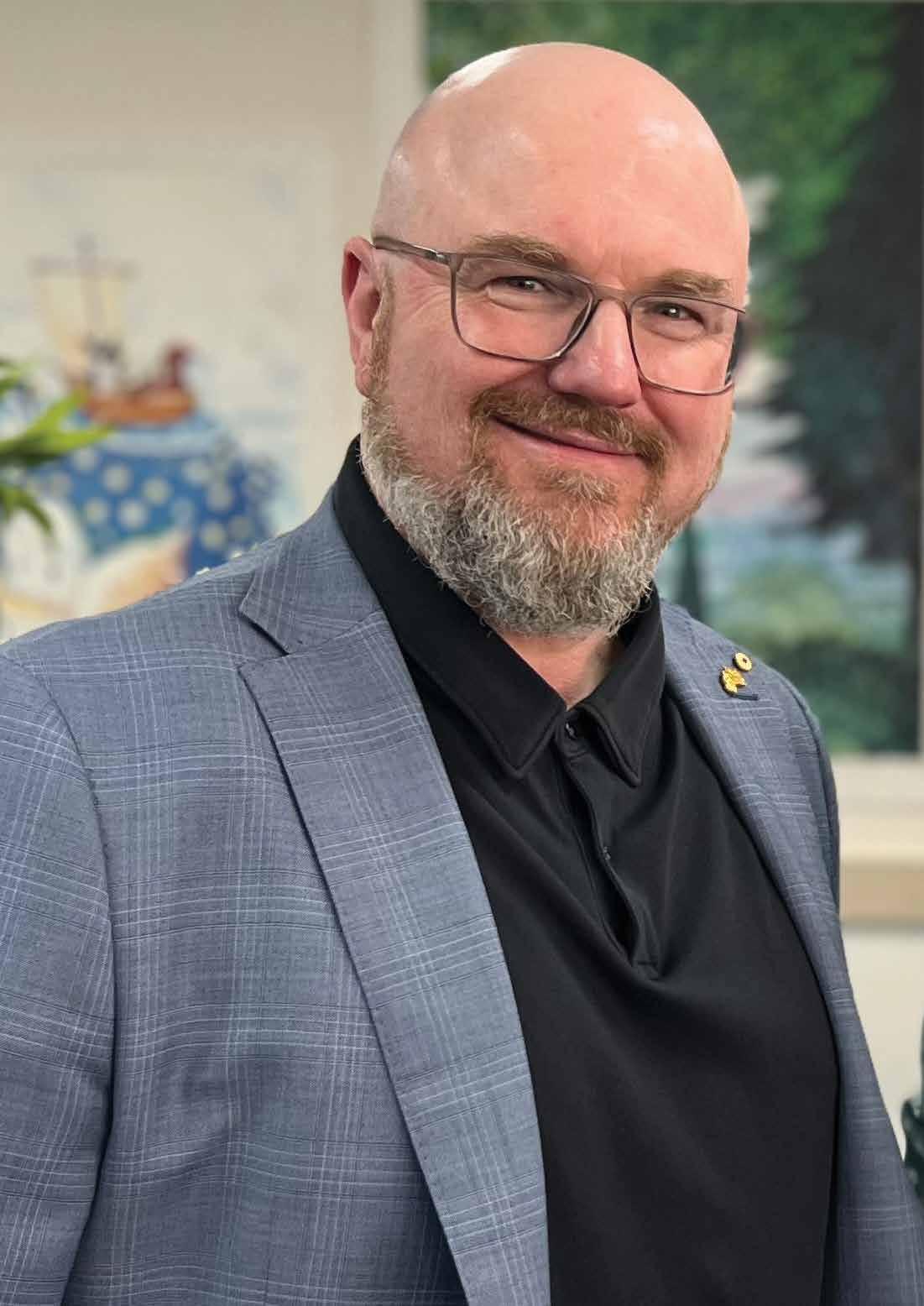
Being kind to people all the time is important, as it could change or even save their life – it’s the simplest gestures that can have the biggest impact.”
Tim Conolan AM, Founder and CEO - TLC for Kids
47
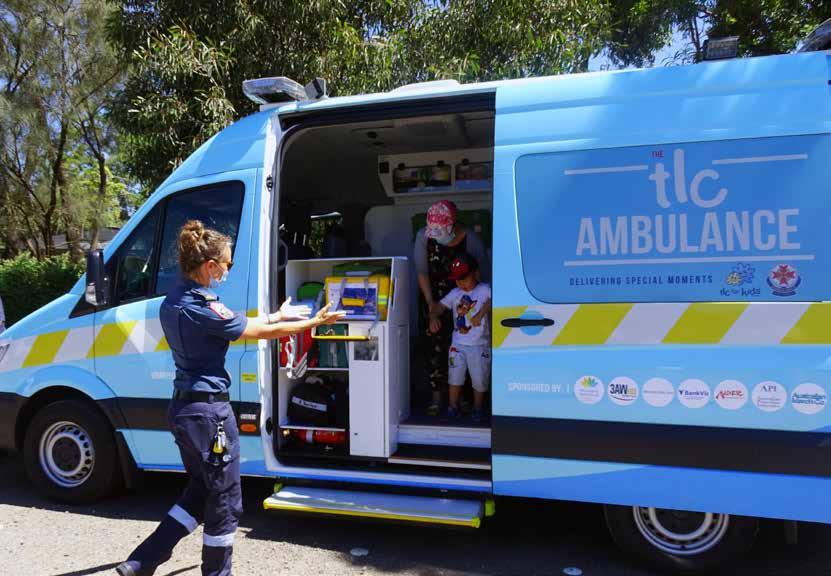
Hailing from Tullamarine, Victoria, Tim Conolan’s inspiring journey through life has been nothing short of extraordinary.
Across a 32-year career, he has been a backyard inventor, motivational speaker, professional DJ, leading up to being a CEO and Co-Founder of a rapidly expanding charity that provides crucial support to children and families grappling with the challenges of living with illness. In this interview, FIRST speaks with Tim about his unwavering passion for helping those in need.


Tim, you’ve had a dynamic and inspiring career to date. Can you tell us a bit about where it all began?
I can trace my biggest drivers back to my childhood. I was fortunate to grow up with a very close, loving family that I always looked up to –and still do. My parents were always involving my brother and me in whatever they were exploring, whether it be meditation, long walks, expeditions, or travel. I think this instilled in us a keen sense of curiosity – that entrepreneurial spirit. When I was about three years old, I was caught red-handed dismantling our VCR recorder; I just wanted to see how it worked!
From a young age, my brother and I were always trying new ideas and dreaming big. At some point, I really wanted to be a spaceman. Still, I settled for more on-the-ground ideas: I attempted to design a perpetual motion torch that could charge itself (it didn’t work) and to create the ‘ultimate’ soft drink flavour, which resulted in my neighbour and me vomiting for three hours in the backyard.
No matter what I was trying my hand at, my family was always in my corner. Their focus on respect, happiness, and the ‘giving it a go’ mentality has stuck with me always. Everything we did centred around the question of ‘how can you make people happy?’. This really started me down the path I’m on today.
48 www.caa.net.au Feature First


Tell us about how you transitioned from backyard science to charity work. Was there a pivotal moment when you realised your calling was to help others?
My professional journey has been quite eclectic, spanning roles as a DJ, karaoke host, and even a pseudo pastry chef. The one thing these roles all had in common was that they were driven by my passion for entertainment and spreading happiness to others.
Together with my brother, a former professional bodybuilder, we embarked on a successful venture in the clothing business catering to bodybuilders. However, the rapid growth of the business overwhelmed us, as we were handling everything from orders to screen printing ourselves. To cope, we decided to outsource manufacturing, but unfortunate circumstances forced us almost to have to sell the business and lose everything we had worked for. This period marked one of the most challenging chapters in my life – we were rock bottom and had to start again from scratch.
Recalling the invaluable lessons in positivity instilled by our parents, we made a conscious decision to turn adversity into an opportunity. We initiated workshops focused on promoting positivity, aimed at guiding young individuals towards a brighter future – helping them navigate exams, avoid the pitfalls of drugs and alcohol, and stay optimistic.
My true ‘sliding doors moment’ came when I was just twenty years old and asked to attend a cancer support group camp as a motivational speaker.
I met a seventeen-year-old boy who ended up only having one month to live, who wound up changing the course of my life. Through him, I realised that while I’ve always harboured a desire to help people, offering support to those who were seriously ill was my calling. It was not a need or a want, I felt I truly had to do this.


How did this realisation lead to TLC for Kids?
My brother and I were inspired to set up ‘Team Life’, an organisation that would become a forerunner for TLC for Kids. We aimed to make a difference for terminally ill kids by giving them something to focus on outside the confines of their hospital beds. To raise funds, we organised concerts, carried out street stunts and sold charity chocolates, with every cent poured into helping distract kids from the hospital environment.
We took them bowling, to the zoo and even on joy flights. Team Life was a small but impactful charitable business, yet, there was an underlying frustration because there was never enough money to help all the kids who were in need, and the focus was on a small number of kids in need.
It wasn’t until I met my life partner Ana Darras that we were able to take the concept to the next level. Through her work in Public Relations at the Royal Children’s Hospital, Ana showed me the vast number of children who were ‘falling through the gaps’ and missing out on emotional support in hospitals.
I had been under the impression that all sick kids could access support through charities, but this was not the case. There was a clear need to set up an organisation that did more, and this is how TLC for Kids was born – a support group to help all children, regardless of their illness, get through what is often the toughest time of their lives.


What is TLC for Kids’ core mission, and how is this brought to life through your services?
Put most simply, we want to put a smile on kids’ faces. We’re focused on helping sick kids feel normal – whether it’s for a few seconds, days, hours or weeks – through practical, emotional or distractional support. Since 1998, we’ve been able to achieve this 15.1 million times and counting.
We do this through our unique Rapid TLC program, the fastest referral system of its kind in Australia. Healthcare professionals contact us to request support for sick children and their families, and then we set to work bringing to life their requests immediately. All requests are actioned within 24-48 hours, if not within the hour, to make sure no child is kept waiting or falls through the gaps.
Offered in over 400 hospitals across Australia and New Zealand, our Distraction Boxes are designed to divert children’s attention away from painful examinations and procedures while assisting healthcare professionals. One primary focus of the Distraction Box program is around infection control and non-pharmacological support for healthcare professionals working with children.
49
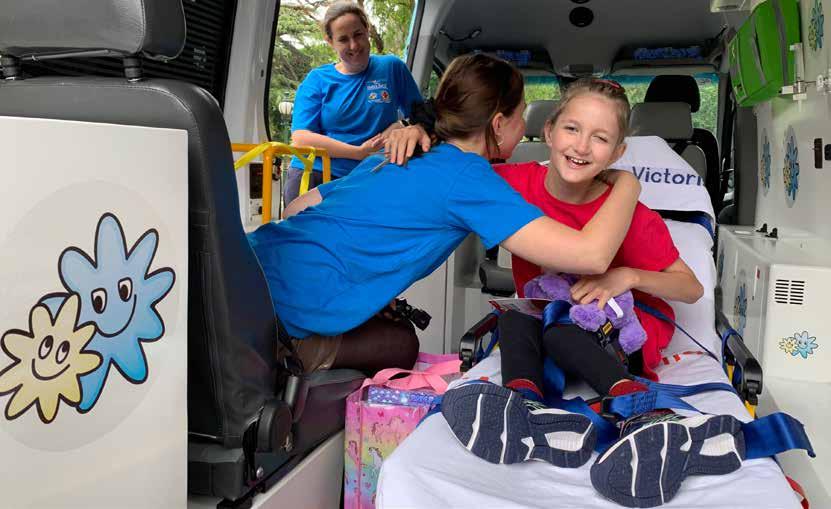
We’re also proud to partner with Ambulance Victoria on the first TLC Ambulance Service, in which volunteer paramedics join us on special trips for children in palliative care, and their families, to have a meaningful and memorymaking day out to a favourite destination. This could be visiting the beach, a zoo, seeing a grandparent or simply spending time at home one last time out of hospital. We host these beautiful days for the families, capturing every moment for them. Sometimes, sadly, this is the last time the family are a whole family together, so the memories created are truly treasured moments.
To help aid the expansion of our reach to thousands more children in need we developed and launched a free app, Tap 2 Distract. A vital digital tool for children and healthcare professionals, the app marks the next evolution of our Distraction Box program. Backed by more than two decades of research and learning, it is a digital tool to support pain management and coping with stressful situations. The app is available as a web version and on the app stores to anyone, anywhere, with a smart device. It is free for all users, with no sign in required, pop-up ads, links to other websites, unnecessary distractions and all content is appropriate for all ages. Our aim is to put the app in the hands of thousands, if not millions of people who need a little positive distraction during stressful times.


How has TLC for Kids evolved over the past 25 years?
I still get goosebumps every time I think about how far we’ve come and how many children and families we have been able to help in some small way. What started with Ana and I working from our garage has become a global organisation. The evolution of our services and our team has been nothing short of amazing.
Thanks to the incredible support of our donors, who have become a huge part of the TLC family, we’ve been able to keep expanding and help more and more families every day. Our services are now offered in hospitals across Australia and New Zealand and are accessed 1.2 million times yearly – that’s 3,500 times a day across various services!
The underlying power behind our achievements is the people that make it possible. We do constant check-ins with hospital staff, parents, kids and stakeholders to get feedback on what services are needed and work with our fantastic board of directors to figure out how we can fill any gaps.
Most importantly, we work quickly. If a service is needed, we do everything we can, as quickly as we can, to get it out there to the best quality possible. To this day, we haven’t yet embarked on anything that hasn’t worked.
Feature First www.caa.net.au 50
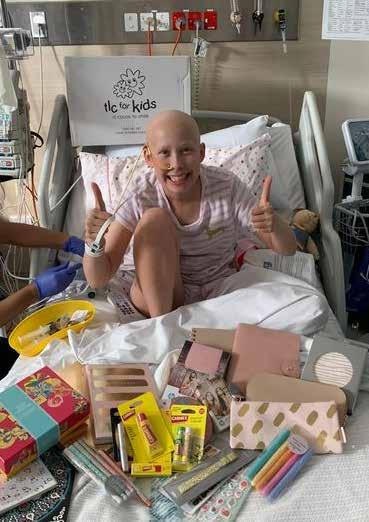
We aimed to make a difference for terminally ill kids by giving them something to focus on outside the confines of their hospital beds.
51
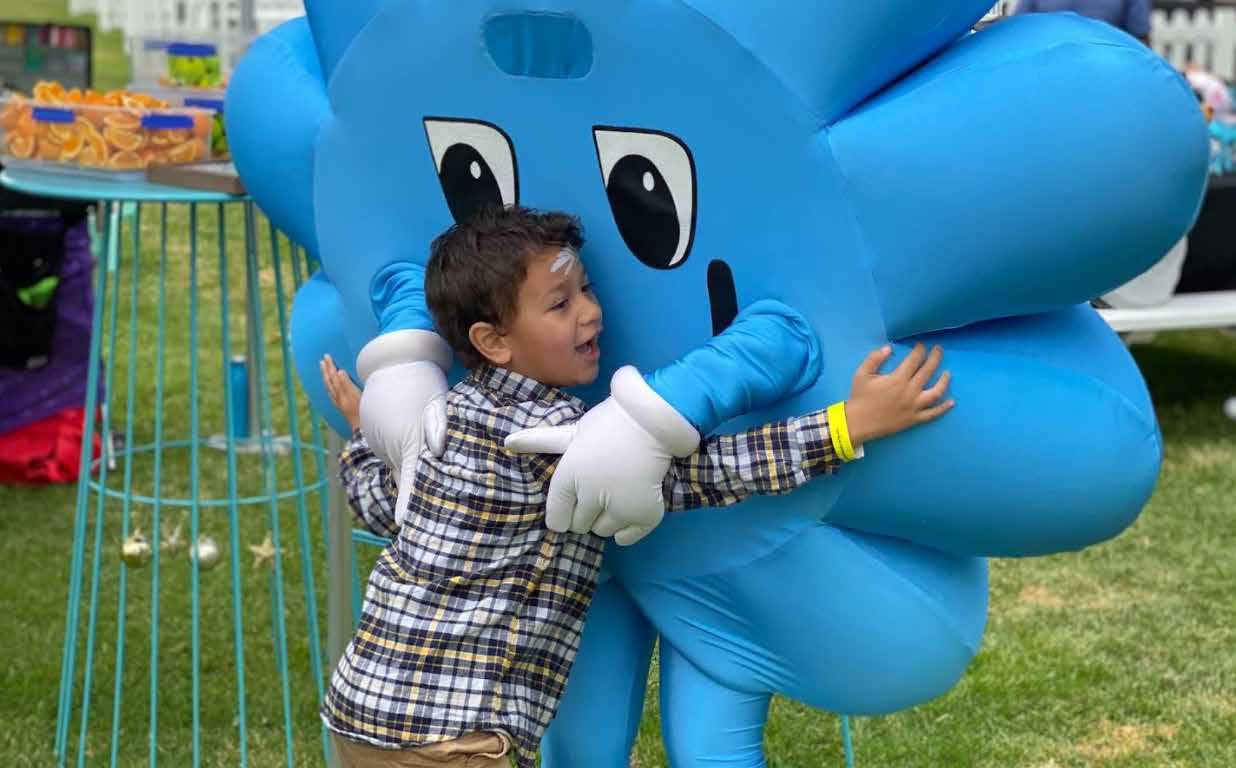


Are there any stories that stand out to you about people whose lives were positively affected by TLC for Kids’ support?
It’s hard to choose; every request we get is so special. Every day, I feel humbled by the depth of trust people place in us. There’s a real sense of privilege that we’re allowed into their lives at such personal moments. But, every now and then, there is a request that pulls a little harder at the heartstrings. One of these is the story of Casey.
Casey was part of a four-day trip we organised for a group of kids, aiming to give them the experience of a lifetime. On the last day of the trip, Casey’s mum approached us and said: ‘You’ve brought our daughter back to us.’ At first, I was confused – of course, we would bring the kids back to their families!
But then she told me that a few days before the trip, Casey had told them she had made a devastating decision. Though she understood the outcome, she wasn’t going to continue with the critical treatment she needed to survive. On the last night of the trip, however, Casey had a change of heart. She called her parents and said: ‘Book in the treatment. I want to live.’


This was beyond meaning for me, and it will stay with me forever. What we were doing was simple: putting people together to boost their morale. That alone was enough to save a life.
I had this realisation that the turning point for someone can be as simple as being a shoulder to lean on. Being kind to people all the time is something that can change, or even save their life – sometimes, it’s the simplest gestures that can have the biggest impact.
You spend much of your life supporting and helping others. Who is your biggest supporter?
Without a doubt, my biggest supporter is my partner, Ana. She’s always in my corner, backing me up through thick and thin. TLC for Kids wouldn’t be here today if Ana didn’t believe in what I’m doing and the work we produce together as co-founders. On top of that, she’s put such a breadth of passion and knowledge into this organisation through her countless contributions.
When I first met her, I felt like I was catching up with an old friend, and that feeling has never gone away. I wouldn’t want to share this journey with anyone else.
Feature First 52 www.caa.net.au


What about professionally – do you have a mentor or someone you look up to for advice?
I’m very fortunate to have had many exceptional mentors throughout my life who have been there throughout some of the toughest times. But I think my biggest supporter and mentor is Tony Walker ASM, former CEO of Ambulance Victoria and current member of TLC for Kids’ Board of Directors.
He’s been invaluable to me in so many ways. When TLC for Kids expanded to offer The TLC Ambulance to our support services, he embraced the idea within seconds. He’s always there to guide me or just bounce ideas off. I can’t express how lucky I’ve been to have Tony by my side.


We know charitable organisations in Australia face many challenges. What hurdles have you and TLC for Kids faced over the years, and how have you overcome these?
Starting a new organisation is always a challenging process, and TLC for Kids was no different. The early days were some of the hardest. To raise funds and keep the lights on, I was working all day and DJing at night. We sold our family home to keep up with demand for support, and, at one point, were living off minced meat and rice with only $94 in the bank. We invested everything into TLC for Kids: heart, blood, sweat and soul.
It still wasn’t enough. We couldn’t keep up with demand, and families were still missing out. While I was drawing on my motivational work to get through, I found it hard to stay positive. I was confused and frustrated: why couldn’t people understand that there were so many families who needed help?
That’s where 3AW’s Neil Mitchell stepped in and literally saved us. After I contacted him for support, he organised an on-air appeal dedicated to raising funds for TLC for Kids, raising $150,000 within three and a half hours. Thanks to him, we were able to get back on our feet as a charity and continue helping those most vulnerable in our community.
Standing out in a competitive landscape remains one of our biggest challenges: every year, more than $190 billion is raised for Australian nonprofit organisations that all provide exceptional support to communities.
Fortunately, TLC for Kids has a strong database of dedicated and supportive donors – our TLC family.
Some of them have been with us for almost 20 years. Thanks to them, we’ve been able to increase our service reach, ease financial doubts and give back to sick kids and their families.
The faith and trust that our supporters put in us is a huge motivator for me throughout the good times and the more challenging ones. Knowing that people are behind us, and relying on us, is what gets me up and keeps me going.


Do you have a mantra that you live by and helps you get through those hard days?
‘A waterfall starts with a single drop of water.’
These words, from author Bryce Courtenay, resonate very strongly with me. I see every TLC for Kids supporter as that single drop of water.
One drop at a time, we form a river, and eventually, this becomes one powerful waterfall of support for kids in need.


What’s up next for TLC for Kids?
There are lots of things on the horizon, but right now, we’re very excited about the potential of the Tap 2 Distract app. It has already proven to be extremely useful in times of stress and it is one of, if not, the only immediately accessible digital tool available to anyone. It also has the ability to help so many more people beyond clinical care who need invaluable support globally. The app is the product of over 20 years of experience and practical knowledge in the space of distraction, occupational, play and diversion therapy.
We hope that app users may also recommend the service to others or possibly become donors themselves in the future – it’s a circle of giving that all goes back into helping our core mission.
In the long term, we’d like the app to be available in all emergency services around the world, including paramedics and fire services, and accessible to anyone.
We also work hard to expand our TLC Ambulance and Distraction Box programs. Our ultimate aim is to have two TLC Ambulance vehicles on the road in each state and territory and increase the number of Distraction Boxes in all hospitals in Australia and New Zealand.
53
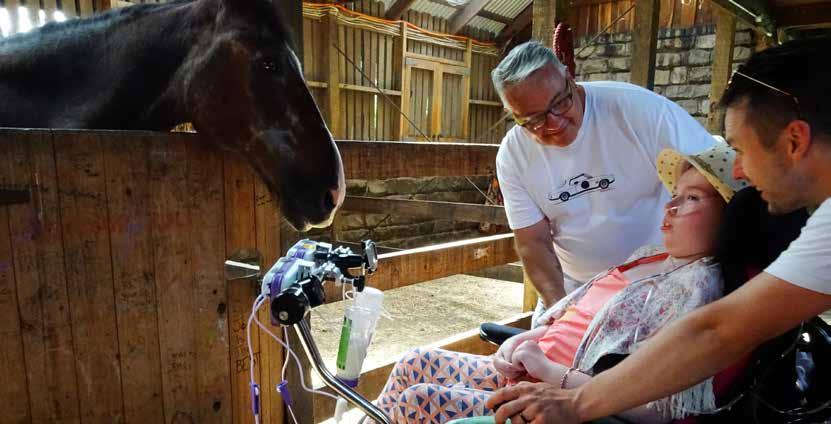


Undoubtedly, readers will be moved by your story and achievements to date. In what ways can our readers get involved with TLC for Kids as volunteers or donors?
Advocacy is one of the main ways you can help. Spread the word about us, and encourage others to do the same. The number of kids we can help is only limited by the donations we receive, and more awareness means more funds that can go straight back into helping kids. Our ethos has always been to ‘never say no to a family in need’, and we remain strongly committed to this.
Every donation has a massive impact, especially regular donations. Our supporters get full transparency about how funding is used, and we keep admin costs very low – around 3% of our total funding, with the rest flowing towards service delivery. That means a massive percentage of every donation goes directly to helping give a little hope and support to those in need.


Any parting words of advice for anyone inspired to follow in your footsteps and help others?
When it comes to supporting charities, do your research – find out who you’re going to support and why. Give not just for the sake of giving but for the sake of getting involved. Becoming a part of the family is one of the best things you can do.
Importantly, always do something that makes you happy. That way, you know that whatever support you’re giving out is also going to make others happy.

Thinking about my own journey and how far I’ve come, I’d also say don’t forget to take the time to reflect on the steps you’ve taken that have brought you to where you are now. It’s so important to stop, look down at your feet, stay grounded. Remember the power of a single drop. To learn more about TLC for Kids, visit
tlcforkids.org.au (about TLC for Kids)
tlcforkids.org.au/app (about Tap 2 Distract)
the following links.
Feature First 54 www.caa.net.au

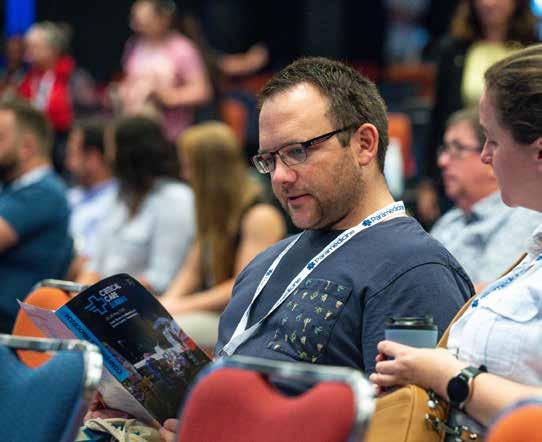
Primary Care Conference 2024
A groundbreaking conference focused on primary care University of Tasmania, Sandy Bay Campus, Tasmania
Research Symposium 2024
Nurturing novice researchers
Australian Catholic University, Brisbane, Queensland
ACP International Conference 2024
Immerse yourself in the latest advancements, hands-on workshops, and dynamic networking opportunities at ACPIC24. The Sydney Masonic Centre, Sydney, New South Wales
CONFERENCE CALENDAR
2024
May July Sept www.paramedics.org @ACParamedicine IC YOURPRE-REGISTER INTEREST paramedics.org/ events REGISTER NOW paramedics.org/ events 16–17 May 18-19 July 11–13 Sept
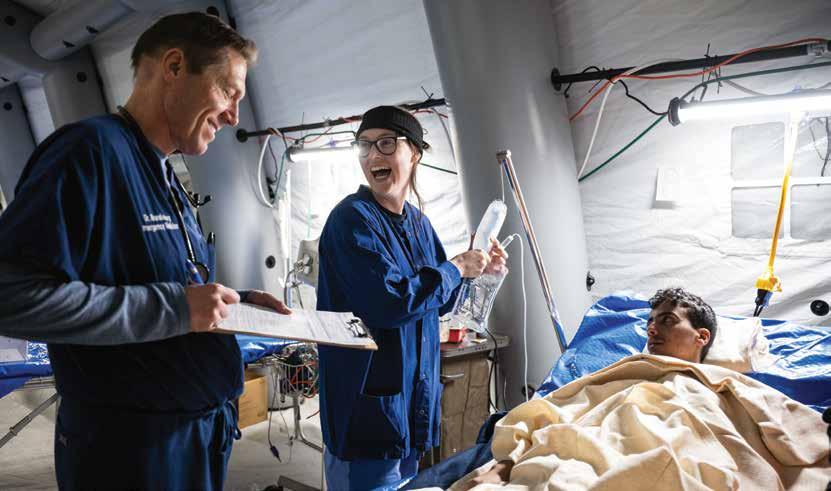
Driving Meaningful Improvements in the Healthcare Landscape
Jessica Hickingbotham, Clinical Solutions Manager, Belgravia eHealth.
The ambulance health sector is made up of many people from a diverse range of backgrounds and experiences, working in frontline services, support roles and in partnership with Ambulance services to deliver better products, services, and ways of doing things – all to improve patient outcomes.
In this edition of FIRST, we meet Jessica Hickingbotham, Clinical Solutions Manager with Belgravia eHealth Jessica has experienced many facets of patient care, from support work in a rural community living and respite environment, to volunteering overseas with disaster response and right up to her current role with Belgravia eHealth.

Jessica, you’ve had quite the varied career, from rural Victoria to working overseas in Türkiye. Could you share with us a bit more about how your career journey so far? How did your interest in telehealth come about?

I guess when I look back on it so far, it has been a bit of a diverse journey!
Partners First
56 www.caa.net.au


Working in the healthcare field has offered me the chance to explore all sorts of roles and avenues, and it's one of the things I appreciate about this profession. The healthcare landscape is always evolving – and I guess this means opportunities and roles that didn't previously exist.
Basically, I started at Goulburn Valley Health's Emergency Department and ICU. From there I developed a greater interest in emergency and critical care, which lead me to do a postgraduate degree in rural critical care.
From there, I’ve ranged far and wide, working on projects, volunteering, getting involved in anything I think will improve patient outcomes. On a side interest, I've also been involved in several immunisation programs!
Throughout my career, I've had the privilege of working in a range of emergency and critical care settings, spanning regional, metropolitan, and even overseas locations. Regardless of whether I’ve been in a regional or metropolitan setting, the core challenges in emergency healthcare remain: a disproportionate demand compared to the available staff, ambulance services, beds, and resources.
Over the years, I've witnessed the toll this imbalance takes on healthcare professionals, including myself, and the impact it has on patient care. It was this one recurring issue that prompted my interest in telehealth.
So, given what you’ve just said, could you tell us a bit more about your interest in telehealth?
I firmly believe that telehealth can be a pivotal solution to address the challenges in healthcare I mentioned earlier. It has the potential to improve healthcare access, enhance community health literacy, reduce time to treatment, lessen the burden on emergency services, and ultimately enhance patient outcomes.
I’ve been lucky enough to collaborate with many different healthcare professionals over the years, and many of these passionate people each have their unique perspectives and ideas on how telehealth can reduce the strain on healthcare systems and, as I said, improve patient outcomes –which is what we’re here for at the end of the day. Telehealth really is a rewarding and continually evolving field.
I'm genuinely excited to see how it will shape the future of healthcare for the better.


How did you come to learn about volunteering work? How did you decide just who to volunteer with? Would you recommend volunteering to FIRST readers?
I've always been passionate about volunteer work, and strongly encouraged by my family. The desire to help others in their time of need has been a driving force throughout my life. This has meant I've always kept my ears to the ground and have also been known to go on google searches looking for volunteer opportunities.
The organisation I currently volunteer with had been on my radar for several years. I distinctly remember hearing about their work on the ground post the 2004 Boxing Day tsunami when I was a teenager. Over a decade later, I decided to investigate disaster response and a deep google search later brought up this organisation. This led to numerous phone calls, emails, interviews, and training. Now I am proud to be a member of this disaster response team that is dedicated to helping those in times of devastation.
Selecting the right organisation to volunteer with is a highly personal decision and can vary from person to person. For me, the most significant factor was that the organisation aligned with my faith and beliefs as a Christian. Other crucial factors included their commitment to serving and treating everyone equally, their rapid response to emergencies where time is critical, their willingness to go wherever the need is, even if it's in uncomfortable or insecure places. It was also vital that the organisation focused on helping, not hindering, and that I could use my existing skills in a practical way. I would also like to say that their strong emphasis on the security and safety of volunteers was crucial in my decision-making process.
Without a doubt, I would wholeheartedly recommend volunteer work to anyone. In fact, you couldn't stop me from encouraging people to get involved!
FIRST readers, if I haven’t sold it to you yet let me tell you a bit more about volunteer work. Volunteer work can be challenging, physically demanding, and at times, emotionally taxing. It can involve long hours and will always require sacrifices. You might not always receive thanks, and you might not immediately see the impact of your work. Ok, so it might not be the most glamours thing to do and if you’re looking for recognition or praise then this isn’t the space. However, if you're looking for a way to use your skills in a practical way to show care and to make a difference, even if it's just to one person, then it is worth it. The positive impact on the lives of others far outweighs the challenges.
57


Could you tell us about your time in Türkiye earlier this year? What type of work were you doing? How long where you there for? Have you been back since, or any plans to?
The disaster response team that I was a part of rapidly deployed and set up an emergency field hospital within a week of the Türkiye earthquakes. The field hospital was located within a carpark of a hospital that had become structurally unsound from the earthquakes. The carpark basically became the base of all healthcare and emergency services for the area, with 600+ paramedics living on site and dispatching from there. Our emergency field hospital had 52 beds, an emergency department, two operating rooms, ICU, pharmacy, pathology, and x-ray.
Initially, we treated earthquake-related injuries like fractures, greater than seven-day old untreated compound fractures, crush injuries, burns, rhabdomyolysis, and injury related infections.
As time went on, we addressed complications and medical issues due to the loss of access to healthcare (including regular medication) and challenging living conditions, including severe respiratory infections, malnourishment in children, new injuries, and scabies just to name a few. There were also the everyday medical emergencies such as pneumothorax and ruptured ectopic pregnancies.
Since my deployment, I haven't returned because the primary focus has shifted to providing shelter and rebuilding. but I would volunteer again without a doubt.
I also want to say, one thing I learned but found challenging was just how hard it was to leave behind people who had suffered immense physical and emotional hardship, including the loss of loved ones, homes, and belongings. I think this will help me if I ever find myself in a response team like the one in Türkiye again.



Thanks for sharing your volunteer story, Jessica. It sounds both rewarding and challenging. Changing subjects a bit, could you tell us a bit more about Belgravia eHealth, and your role there?
Belgravia eHealth is an Australian based company that has been in operation for just over 12 years. We primarily focus on providing eHealth solutions and services, particularly in the field of ambulance secondary triage. We have been working with ambulance services across Australia for the last six years and are currently deployed in Victoria, South Australia, Tasmania, the ACT, and Western Australia. The company specialises in leveraging technology to enhance resource allocation, improving clinical support, and generating operational efficiencies within the ambulance and emergency medical services sector.
Within Belgravia eHealth, my role involves taking responsibility for all clinical aspects of our solution. It’s very broad and quite enjoyable because I’m responsible for parts in training, ensuring the clinical content is up to date, reviewing and improving clinical processes, and enhancing clinical excellence. I also collaborate between ambulance services, clinical teams, and our IT team to turn clinical ideas and improvements into practical solutions.
That is very diverse, and clearly draws on past experiences and skills. How do you think your nursing work, including the time spent in Türkiye helps your work with Belgravia and Ambulance services?
Without a doubt my nursing experience - including my time in Türkiye - has been invaluable. It has exposed me to a wide range of healthcare settings, helping me recognise common challenges across the sector such as resource allocation and limited health literacy within communities. I’d also add that working with professionals from various backgrounds has enriched my knowledge and I’ve been fortunate enough to learn from their best practices and innovative ideas.
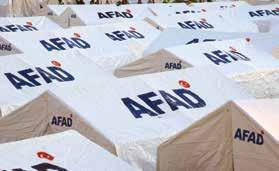
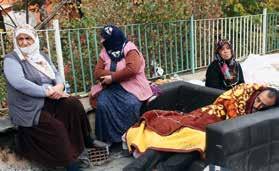
58 www.caa.net.au
Partners First



Given your amazing experiences on hospital wards, out in the field and now working in partnership with Ambulance services as a clinical consultant, what’s next for you and Belgravia do you think?
Belgravia eHealth’s goal is to alleviate the burden on these services while increasing health literacy, healthcare quality, and overall health outcomes.
What’s next for Belgravia eHealth is continuing to work in close collaboration with emergency and health services to drive meaningful improvements in the healthcare landscape.
Ways we are doing this include integrating systems and technologies like updating CAD systems automatically, cutting down on data entry, making sure clinicians are working on the patients with the most need, improving data on patient outcomes, improving pathways in patient access to health literacy, and providing services and stakeholders with a greater understanding of the impact of their service delivery.
On a personal note, I’m eager to continue growing, stretching, and challenging myself and build on my current emergency nurse background. The role I have at Belgravia eHealth exposes me to broader issues in the delivery of care and I am keen to continue and expand any projects that look at solutions in addressing the challenges that are facing the emergency healthcare sector. I also plan to continue to do more work with the Disaster Assistance Response Team wherever and whenever the need arises. And did I mentioned I encourage FIRST readers to consider volunteering?


Finally, the last question we always ask is, if you could give 15-year-old Jessica some career advice before she starts out on her journey, what would it be?
The emergency healthcare space is undoubtedly exciting and dynamic, allowing you to experience and do things you wouldn't find anywhere else. The demand and intensity can be relentless, and it's easy to work long, unceasing hours, and feel the expectation to appear unaffected by what you've witnessed and experienced. It might seem that to be an emergency health professional is to be superhuman.
You are not. You're human, just like your colleagues. You have physical and emotional limitations, and the toll this work can take on your mental, emotional, physical, spiritual, and social well-being is significant. The most crucial piece of advice I can offer is to take care of yourself and your colleagues.
Remember to prioritise your mental, emotional, and physical health. Recognise when you need rest and downtime. Don't hesitate to talk about how you're feeling, the challenges you're facing, and the impact this work has on you. It's not a sign of weakness; it's a sign of strength to seek support and take care of your well-being. You and your colleagues will only be able to continue the work in helping the wider community if you also look after yourself and your fellow emergency healthcare colleagues.
59

Celebrating 30 years of AFAC Conference and Exhibition
AFAC24powered by INTERSCHUTZ returns to Sydney on 3-6 September 2024, marking 30 years of the event, and an opportunity to celebrate its continued growth to become Australasia’s premier emergency management conference and exhibition.
The AFAC Conference brings a broad spectrum of emergency management practitioners together to learn and share experiences. Each year, delegates engage with the latest research and practice in this multistreamed conference, incorporating streams such as the Australian Disaster Resilience Conference and the Institution of Fire Engineers (Australia) National Conference.
AFAC24 is looking to build on the success from last year’s conference when it returns to Sydney at the ICC. Last year, AFAC23 attracted a record attendance of over 3,500 emergency management personnel to Brisbane, showcasing over 230 exhibitors with much on offer for our diverse emergency management sector.
Registrations are now open for the event, offered at an early bird rate until 30 June. Secure your place to be part of this special 30-year anniversary of the AFAC Conference and Exhibition.
60 www.caa.net.au
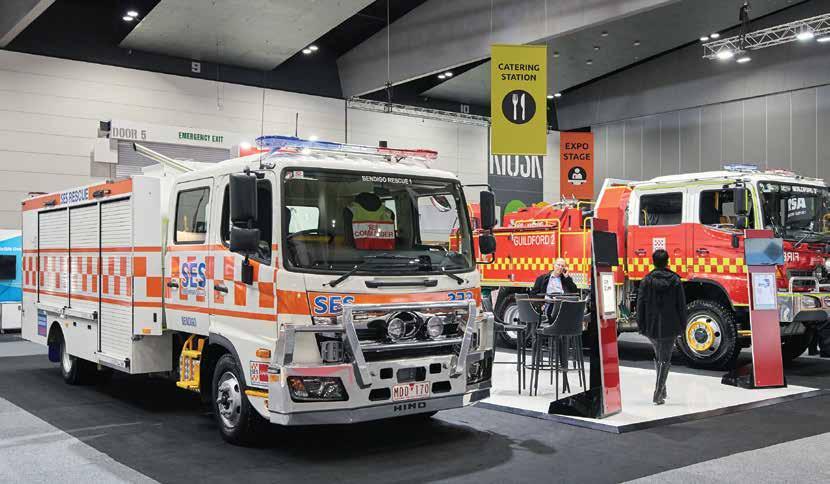
What to expect from AFAC24
While it is important to look back on the last 30 years of the AFAC Conference and Exhibition, AFAC24 has its eyes firmly set on the future. This year’s conference explores the theme, ‘Embracing innovation and disruption: Designing the future for our sector’. Right now we can see an immediate need for fire and emergency services to adapt to be prepared for the future. As we come together for AFAC24, we are dedicated to fostering an inclusive culture that encourages new ideas and diversity of thought from across the sector.
AFAC24 will offer ambulance personnel access to valuable insights on the latest research, trends, and techniques in disaster resilience and emergency response. The conference and exhibition attract a wide range of emergency management professionals, including those from fire services, national parks and surf life-saving.
Ambulance personnel will have a unique opportunity to network with a diverse group of emergency responders, fostering collaborations and sharing of best practices.
Last year’s exhibition showcased over 85 exhibitors providing specialised solutions for ambulance services, as well as the latest advancements in emergency preparedness and response, such as body worn cameras, push-to-talk solutions and much more.
AFAC CEO Rob Webb said, “This is the largest emergency management conference in Australasia, so we have a unique and valuable opportunity every year to come together across practices to network, collaborate, and discover the latest science and tech to support our work into the future.”
This year the exhibition will see the return of the Demonstration Zone – a space dedicated to the latest equipment, technology and best practices showcased across the three-day exhibition. Previously, the space has included robotics, virtual reality equipment, rescue simulations and much more.
The exhibition will also feature a comprehensive Solutions Theatre program with practical presentations aimed at helping those at the frontline of emergency management. Topics have included innovations and new technologies, mental health, wellbeing, community, resilience, trucks and PPE.
We look forward to welcoming the emergency management sector to AFAC24 on 3-6 September in Sydney to connect with each other, celebrate knowledge and achievements, and continue to grow this important event for the sector.
For more information, including registration options, visit: afacconference.com.au
61

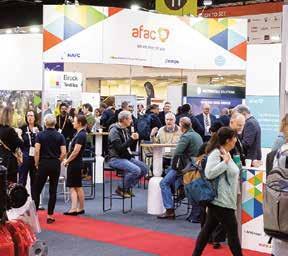




ICC SYDNEY Delivered by Australasia’s premier conference and exhibition for emergency management AFAC24 delivers solutions to these industry sectors: Fire Emergency/rescue First responders Hazardous Resilience Mining Fire prevention Critical infrastructure Public safety ➤ afacconference.com.au #afac24
3–6 SEPTEMBER 2024

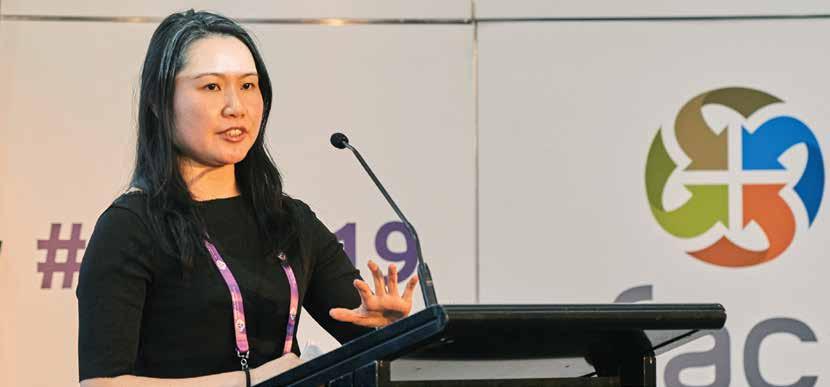


Seasonal Bushfire Outlook Autumn 2024: Australia’s national picture of fire potential
AFAC, the National Council for fire and emergency services, has released the Seasonal Bushfire Outlook for Autumn 2024.
The Seasonal Bushfire Outlook for Autumn 2024 is a reminder to communities and businesses across the country to prepare for bushfire and monitor local conditions.
Australia’s summer temperatures were generally average to warmer than average for most of the country, and this will continue into autumn with maximum and minimum temperatures very likely to be above median across almost all of Australia.
Rainfall during autumn is likely to be below median across much of northern, eastern and southwestern Australia. Elsewhere there is no significant shift towards being wetter or drier than average.
This autumn, an increased risk of fire is identified for locations in Western Australia and the Northern Territory.
AFAC CEO Rob Webb said: ‘An increased risk of bushfire makes it even more important for you to take action. But no matter where you are in Australia, you can stay safer and support your local fire agency by staying alert this season.’ he said.
‘The end of summer does not signal the end of bushfire risk for Australia and communities should be mindful of residual risk in their area. Fire authorities may also begin to undertake prescribed burning during autumn, and communities should stay informed to mitigate the impact of smoke exposure.’
State and territory fire authorities will continue to monitor local bushfire conditions closely through autumn manage risks accordingly. Communities should stay informed and prepared, and check official sources for advice and warnings, including prescribed burns.
Fire potential can vary greatly, even at the smaller scale, between bordering states and territories. Each state and territory’s assessment takes into account different land use types and vegetation types. This is influenced by different forecasts for temperature and rainfall over these regions.
This Seasonal Outlook was developed by the Bureau of Meteorology, Queensland Fire and Emergency Services, the NSW Rural Fire Service, ACT Emergency Services Agency, ACT Parks and Conservation Service, Country Fire Authority, Department of Energy, Environment and Climate Action Victoria, Tasmania Fire Service, SA Country Fire Service, Department of Fire and Emergency Services and Department of Biodiversity, Conservation and Attractions WA, Bushfires NT and AFAC.
63
Standardised guidelines needed to enable broader paramedic integration across the health sector
By John Bruning, CEO, Australasian College of Paramedicine
As paramedicine continues to evolve in Australia and Aotearoa New Zealand, a growing number of paramedics are now working in a broader range of primary, community and urgent healthcare environments, from general practice medical clinics and hospitals through to residential aged and palliative care.
In so doing, they are at the forefront of what is now a transformational shift for both the profession and the health system.

The heightened recognition of paramedic capabilities among governments and healthcare providers, coupled with the increasing willingness of service providers to employ paramedics in different practice settings, marks the start of new era of public health delivery. What is abundantly clear is that the traditional siloing of health professions is undergoing rapid change and that the future lies in multidisciplinary team-based care.
This is a win-win situation for public health in improving out-of-hospital care and alleviating the pressure on our over-burdened hospitals and ambulance services, and for paramedics, offers new career pathways, more professional opportunities, greater flexibility, and bolsters workforce longevity and retention.
However, without the commensurate development of a more cohesive and streamlined approach to defining the depth and breadth of paramedic practice, we compromise the ability to realise the full potential our profession. What is imperative as we navigate this new health landscape is the development of consistent professional, clinical and governance standards that are applicable across employers, locations and practice settings; standards that reflect the reality of contemporary paramedicine and that enable paramedics to work to their full capabilities.
At present, paramedics working outside of jurisdictional ambulance services operate under the clinical practice guidelines and standards of individual employers, which can markedly vary in professional responsibilities and the types of duties undertaken, often with a focus on employer risk tolerance more than contemporary evidence-based care. This partly mirrors the wider, more systemic lack of understanding that still exists across the health sector about paramedics’ capabilities and how their integration can complement existing modes of practice and improve public healthcare.
Partners First
www.caa.net.au 64
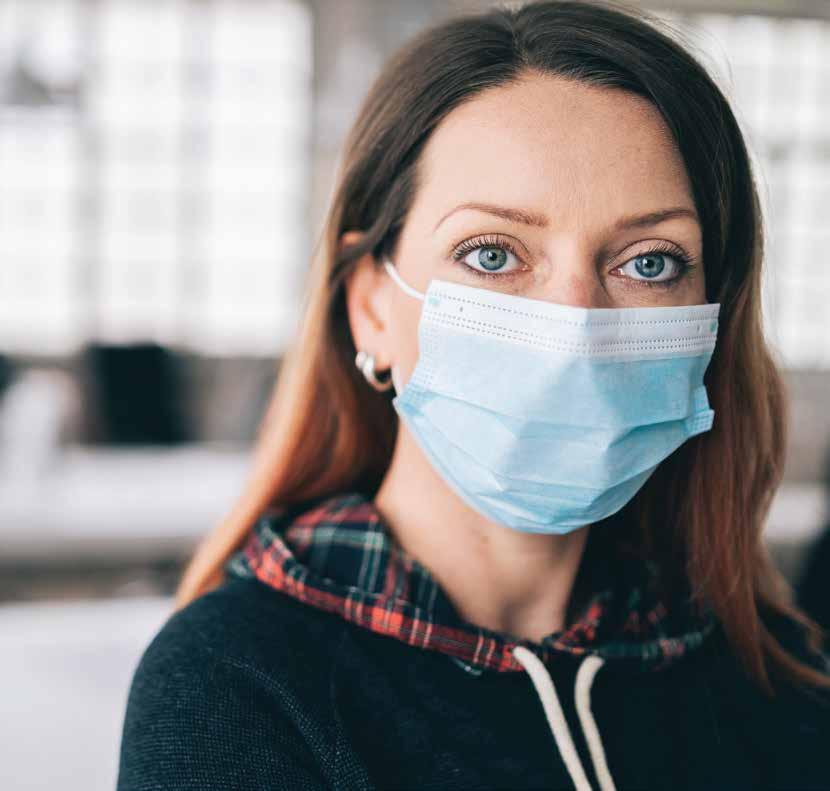
More broadly though, it illustrates the challenges that we still face as a profession and the need for an overarching reconceptualisation of the role paramedicine can play in delivering more responsive, holistic and accessible healthcare.
In the Australian context, many of the current barriers were highlighted in in the first Issues paper in the Federal Government’s “Unleashing the Potential of our Health Workforce: Scope of Practice Review” released in January, including perverse funding arrangements and a lack of appropriate enabling employer practices and settings. According to the paper, “it is well established that what paramedics are credentialled to do in their specific clinical setting often excludes certain activities they are trained and able to do.”
Medical practices that are already employing paramedics are witnessing first-hand the benefits and flow-on effects for their communities - improved access to treatment and care, reduced patient wait times, more treatment options, and urgent care that can be delivered in situ, easing pressure on our ambulance services and hospital emergency departments.
In short, it’s efficient, it works, and it makes sense. With health systems in crisis in both Australia and Aotearoa New Zealand and solutions urgently needed, now is the time to prioritise the establishment of the appropriate frameworks, standards and funding mechanisms for expanded paramedic workforce integration across different practice settings for the betterment of all.
65
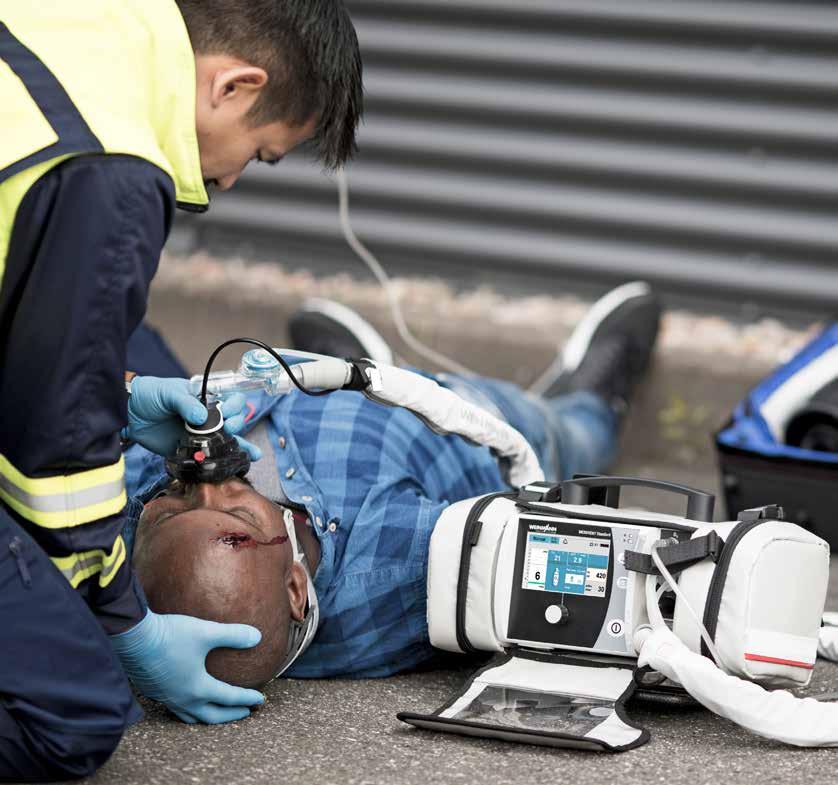
MEDUVENT Standard Ventilate Wherever
You Go
Challenges in emergency response are part of the everyday life of rescuers. Long distances and long transport times are problematic, as the oxygen supply is limited in most cases. With MEDUVENT Standard from WEINMANN Emergency you have a ventilator that works independently of oxygen. Thanks to turbine technology, it can ventilate patients without an external gas supply. With the low-flow supply you can easily supply patients with medical oxygen or concentrator oxygen.

Distributed by RAPP Australia Pty Ltd Phone: (03) 5284 0925 E-Mail: sales@rappaustralia.com.au Website: www.neann.com.au
Rapid start Intuitive and ergonomic Lightweight and compact Contamination protection 21% - 100% FiO2 Mix in O2 at any time
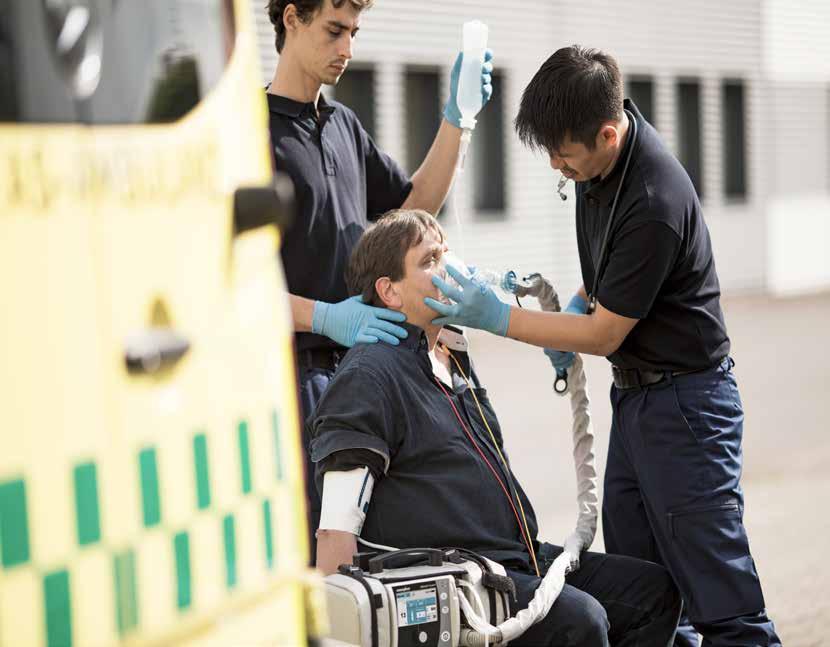
Ventilation makes a difference.
Eva Wild and Vanessa Kühn
Airway management and ventilation are some of the most important, yet challenging situations faced by EMS.
Manual ventilation seems to be an easy task but various studies show that it is difficult, despite regular training. In extreme situations, ventilation must maintain respiratory function and ensure oxygen supply if the patient is unable to breathe on their own.
Resuscitation is one extreme situation where the quality of ventilation matters and consistent ventilation can be life-saving [1]
• What is now the best way to ventilate?
• And what are the advantages of manual and mechanical ventilation?
Research First
67
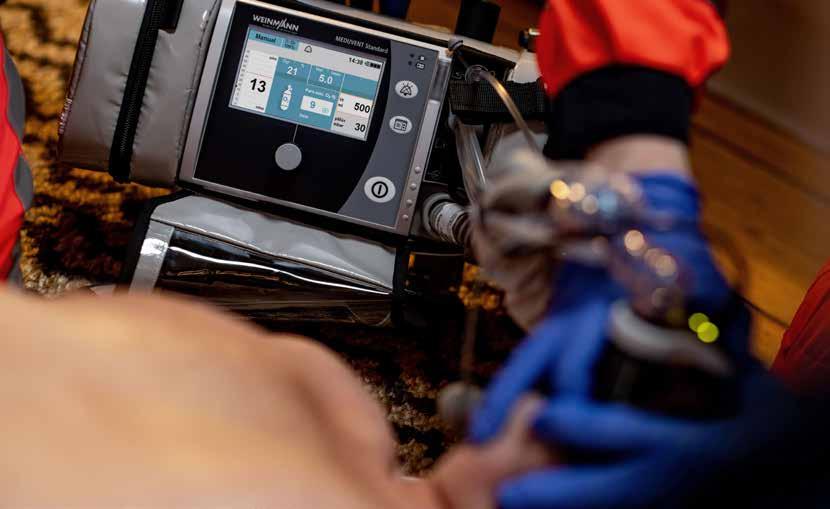
Different types of ventilatory support
Spontaneous breathing is an autonomous, physiological process which, in a healthy person, takes place continuously and without conscious control, especially during sleep. However, under certain pathophysiological conditions, such as serious trauma or illness, this capacity may be impaired or lost completely. Various ventilation methods are required to support respiratory function.
For manual ventilation, a resuscitator such as a bag-valve-mask is used via a ventilation mask, supraglottic airway or endotracheal tube.
Mechanical ventilation, on the other hand, is a method whereby a ventilator is used to regulate and support alveolar ventilation. This guarantees a constant volume and a constant respiratory rate. Positive airway pressure ensures that the respiratory gas is transported into the lungs.
Why is manual ventilation difficult?
Bag-valve-mask ventilation is a method that is frequently used because it is supposedly easy to do, fast and lightweight. It involves attaching a resuscitator, which is usually connected to an oxygen source, to a face mask. The mask is held on the patient’s face, covering both nose and mouth.
At the same time, the resuscitator is squeezed, causing oxygen to flow through the patient’s airways. The valve prevents the oxygen flowing back into the resuscitator.
“In only 3 out of 106 cases all guideline-relevant ventilation parameters were met with bag-valve-mask ventilation during CPR” [2]
Research First
68 www.caa.net.au
“Using a ventilator, EMS providers can complete more tasks, document them more fully, and provide the patient with better care.” [6]
Free airways, an adequately sealed mask and the correct technique are key for this procedure. Two first responders are normally required. In actual fact, this method is not easy to implement, and studies show that even experienced EMS providers have difficulties with it [2]
Most importantly, it lacks a reliable method for measuring the ventilation volume or the pressure that is exerted on the airways.
The delivery of oxygen by squeezing the resuscitator can only be controlled to a limited extent. Without real-time feedback, there is a high risk of excessive ventilation volumes or dangerous pressure peaks that can cause damage to the lungs.
A further problem with bagvalve-mask ventilation can be an excessive ventilation rate with too many breaths per minute. This hyperventilation may have negative effects on the patient’s circulatory condition [3]
Advantages of ventilators
Mechanical ventilation offers a number of advantages in direct comparison with bag-valve-mask ventilation. Studies show that mechanical ventilation leads to a better ventilatory status in terms of arterial blood gases and heamodynamic parameters of the patient even when transport times are short [4] [5]
Ventilators are also advantageous when it comes to crew resource management (CRM). Usually, two EMS providers are required for effective bag-valve-mask ventilation. Ideally, one person should attach the mask to the patient’s face and hold it in place, while the other person carries out the actual ventilation. However, this ties two EMS providers to one task.
In contrast, the advantage of ventilators is that EMS providers are freed up to perform other tasks and document the emergency, so the patient can be given better and more effective care [6]. This reduces the manual work required and allows medical staff to concentrate on the cause of the emergency.
At first glance, the equipment for bag-valve-mask ventilation looks more compact and lighter to carry, but ventilators can also be lightweight and portable. In addition, they are easy to operate, and their functionality is less dependent on the EMS provider’s precise technique than is often the case with bag-valve-mask ventilation.
Scenarios involving mechanical ventilation in emergency medicine
Mechanical ventilation can be used in various areas of emergency medicine.
In emergency situations such as a cardiac arrest, it is essential to resuscitate the patient as quickly as possible and to ensure an adequate oxygen supply as well as CO2 removal. Mechanical ventilation can save lives during resuscitation by reliably maintaining gas exchange.
Mechanical ventilation is also important for transportation in an ambulance or during patient transfer. It ensures a constant and continuous oxygen supply during transportation, without EMS providers having to concentrate on applying manual ventilation.
However, ventilators are not only used during invasive ventilation –pre-hospital non-invasive ventilation can also be supported with different ventilation modes, for example when using CPAP therapy to treat a cardiac pulmonary edema.
69

What is now the best way to ventilate?
Coming back to the original question – from our perspective a BVM is essential and will continue to have its place, at least as a back-up device. However, out-of-hospital mechanical ventilation should be established in EMS as early as possible to maximize patient safety and guaranteeing the best and most consistent treatment, even when transport times are short.
Reference [1] Idris AH, Aramendi Ecenarro E, Leroux B, Jaureguibeitia X, Yang BY, Shaver S, Chang MP, Rea T, Kudenchuk P, Christenson J, Vaillancourt C, Callaway C, Salcido D, Carson J, Blackwood J, Wang HE. Bag-Valve-Mask Ventilation and Survival From Out-of-Hospital Cardiac Arrest: A Multicenter Study. Circulation. 2023 Dec 5;148(23):1847-1856. doi: 10.1161/CIRCULATIONAHA.123.065561. Epub 2023 Nov 12. PMID: 37952192; PMCID: PMC10840971.
[2] Neth MR, Benoit JL, Stolz U, McMullan J. Ventilation in Simulated Out-of-Hospital Cardiac Arrest Resuscitation Rarely Meets Guidelines. Prehosp Emerg Care. 2021 Sep-Oct;25(5):712-720. doi: 10.1080/10903127.2020.1822481. Epub 2020 Oct 6. PMID: 33021857.
[3] Aufderheide TP, Sigurdsson G, Pirrallo RG, Yannopoulos D, McKnite S, von Briesen C, Sparks CW, Conrad CJ, Provo TA, Lurie KG. Hyperventilation-induced hypotension during cardiopulmonary resuscitation. Circulation. 2004 Apr 27;109(16):1960-5. doi: 10.1161/01.CIR.0000126594.79136.61. Epub 2004 Apr 5. PMID: 15066941.
[4] Hernández-Tejedor A, González Puebla V, Corral Torres E, Benito Sánchez A, Pinilla López R, Galán Calategui MD. Ventilatory improvement with mechanical ventilator versus bag in non-traumatic out-of-hospital cardiac arrest: SYMEVECA study, phase 1. Resuscitation. 2023 Nov;192:109965. doi: 10.1016/j.resuscitation.2023.109965. Epub 2023 Sep 12. PMID: 37709164.
[5] Chauhan A, P Rajesh VS, Pujara J, Singh G, Patel P, Patel K, Pandya H. Comparison of hemodynamic consequences of hand ventilation versus machine ventilation for transportation of post-operative pediatric cardiac patients. Ann Card Anaesth. 2023 Apr-Jun;26(2):166-170. doi: 10.4103/aca.aca_54_22. PMID: 37706381; PMCID: PMC10284486.
[6] Weiss SJ, Ernst AA, Jones R, Ong M, Filbrun T, Augustin C, Barnum M, Nick TG. Automatic transport ventilator versus bag valve in the EMS setting: a prospective, randomised trial. South Med J. 2005 Oct;98(10):970-6. doi: 10.1097/01. smj.0000182177.01436.70. PMID: 16295811.
Research First 70 www.caa.net.au
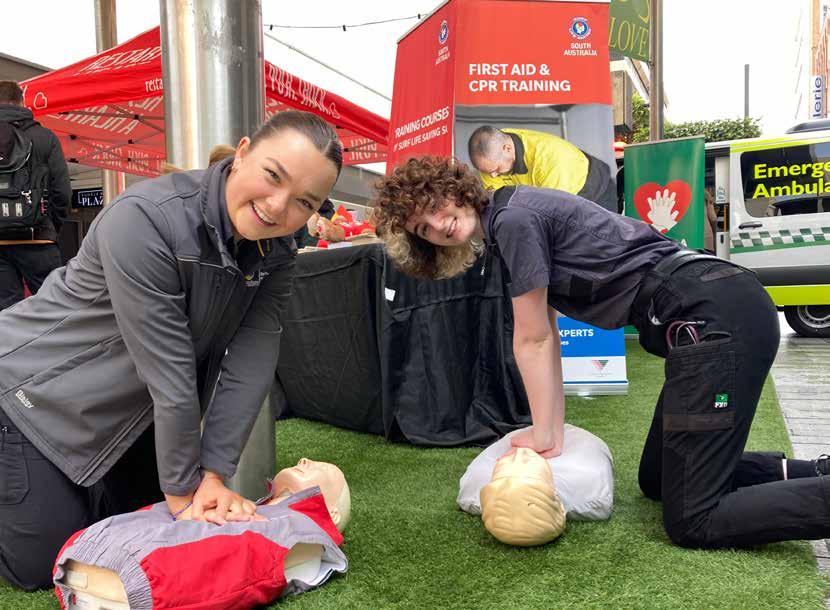
Empowering the Next Generation: CPR Training in Schools
The Council of Ambulance Authorities Research and Policy Manager Dr. Shohreh Majd
Despite advancements in medical technology, global OHCA survival rates remain alarmingly low. In response to this challenge, the Australian Journal of Integrated Research in Health and Disease recently published a groundbreaking article titled
“Evaluation of Cardiopulmonary Resuscitation (CPR) Training Programs to Schoolchildren: A Comprehensive Systematic Review” by Dr. Shohreh Majd, David Waters, and Mojca Bizjak-Mikic. This report examines the significance, effectiveness, challenges, and recommendations regarding CPR training programs in school settings.
71
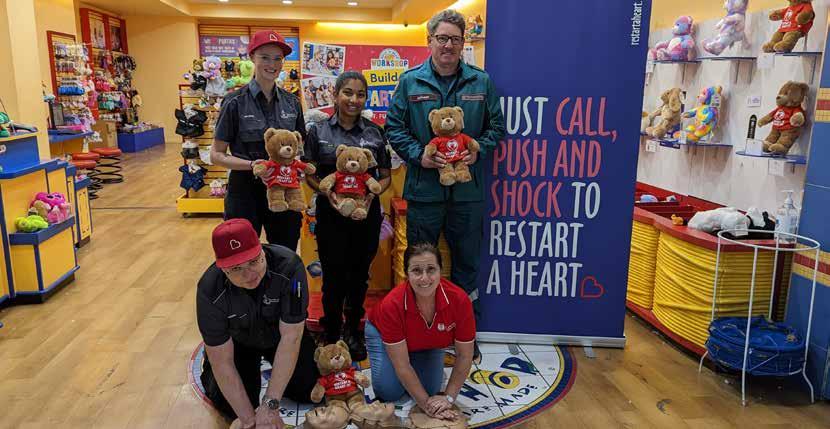
Methods
Dr. Majd and her colleagues conducted a thorough systematic review following the Preferred Reporting Items for Systematic Reviews guidelines. They analysed a comprehensive array of studies from major databases up to the end of August 2023. Sixty-three articles met the inclusion criteria, focusing on CPR training effectiveness for students aged 4 to 18. The review encompassed various methodologies, including experimental designs, to assess outcomes related to knowledge, skills, behaviour, and confidence.
Results
This comprehensive review underscores the pivotal role of CPR training programs within school environments, offering a vital pathway towards enhancing survival rates in cases of out-ofhospital cardiac arrest (OHCA). Integrating CPR education into school curricula presents an opportunity to cultivate a generation of individuals equipped to respond effectively during emergencies. The review reveals compelling evidence of the effectiveness of CPR training programs, showcasing their capacity to augment students’ knowledge, skills, and confidence levels across various age groups.
It has been shown that even brief training sessions have significant enhancements in CPR awareness among students, indicating the profound impact of early education in life-saving techniques.
Longitudinal studies further emphasise the enduring retention of CPR skills over time, reinforcing the value of initiating such training at a young age. The adaptability of training methods to align with students’ developmental stages enhances inclusivity and efficacy, ensuring that CPR education resonates with diverse learning needs.
The involvement of schoolteachers as CPR trainers highlights their indispensable role in creating a culture of preparedness within educational settings. Leveraging the schoolteachers’ pedagogical expertise greatly assists them in playing their critical role in imparting essential life-saving skills, thus underscoring the significance of their contribution to the broader landscape of emergency response education.
Research First 72 www.caa.net.au

Challenges
and
While the benefits of CPR training in schools are undeniable, several challenges hinder seamless integration. These include curriculum alignment, teacher preparedness, resource allocation, and ensuring consistent quality of training. Addressing these challenges necessitates collaborative efforts and dedicated resources to ensure successful implementation.
Conclusion

Dr. Shohreh Majd Research and Policy Manager, The Council of Ambulance Authorities
In conclusion, the article provides invaluable insights into the efficacy and challenges of CPR training programs in schools, advocating for their widespread implementation to equip future generations with life-saving skills. The cumulative evidence underscores the necessity of standardised CPR education in schools and the need for better integration within curricula. It's apparent that leveraging evidence-based educational pathways and addressing societal attitudes and geographical disparities, will lead to developing a comprehensive CPR training for schoolchildren and equipping them with lifesaving skills towards building a culture of preparedness within communities.
Reference Majd, S., Waters, D., & Bizjak-Mikic, M. (2024). Evaluation of Cardiopulmonary Resuscitation (CPR) Training Programs to Schoolchildren: A Comprehensive Systematic Review. Integrated Research in Health and Disease Journal, 2(1), 30–39. https://doi.org/10.5281/zenodo.10828254
Shohreh is a pioneering Neuroscientist, University Lecturer, Manager specialising in leading Research and Policy guidelines, Editor-in-Chief, and an Inspiring Motivational and Self-help Speaker.
With over two decades of dedicated research and teaching in human physiology and neuroscience, She possesses a profound zeal for unraveling the intricacies of the human brain. Her commitment lies in integrating cutting-edge scientific insights to harness the brain's transformative potential for fostering positive change and empowering individuals to reach their utmost potential through the application of science-backed knowledge.
73
Sustainability Promoting in Ambulance Services

The Council of Ambulance Authorities (CAA) stands resolute in its dedication to sustainability, recognising the critical need to reduce the environmental impact of ambulance services while ensuring the highest standards of patient care.
Acknowledging the urgency of shrinking the environmental footprint of ambulance operations, the CAA pledges to develop a comprehensive white paper aimed at advancing this pivotal objective.
The White Paper on Sustainability in Ambulance Services
Sustainable practices encompass a range of initiatives designed to curtail energy and water consumption, minimise waste generation, advocate sustainable transport solutions, endorse environmentally conscious procurement practices, and mitigate greenhouse gas emissions.
Beyond the ecological imperative lies a nuanced understanding of the economic and social ramifications of environmental degradation. Among the myriad threats, climate change looms large with farreaching implications for Australia’s economy, particularly in sectors such as agriculture, tourism, and infrastructure. As the imperative to address these challenges intensifies globally, the need for sustainable environmental policy within emergency services becomes increasingly apparent.
Implementing sustainable practices within emergency services presents challenges, including a pervasive lack of awareness and comprehension regarding sustainable methodologies, the financial burden associated with their implementation, and a dearth of regulatory mechanisms incentivising their adoption.
Sustainability www.caa.net.au
74
However, amidst these challenges lie opportunities—chief among them being potential cost savings derived from energy and water efficiency measures, the cultivation of a favourable public perception through sustainable initiatives, and the prospect of commendation and support for sustainability endeavours.
Central to the CAA’s commitment to sustainability is the white paper on sustainability in ambulance services. This comprehensive document underscores the significance of integrating sustainable practices into healthcare transportation. It delineates sustainability in healthcare and ambulance services as the adoption of measures aimed at mitigating the adverse environmental impacts inherent in these sectors.

Embracing these principles enables ambulance services to align with broader environmental stewardship objectives while simultaneously enhancing operational efficiency.
As the CAA embarks on this journey towards sustainability within ambulance services, it underscores not only a commitment to environmental stewardship but also a dedication to fostering innovation and resilience within the healthcare landscape. Through concerted efforts and collective engagement, the vision of sustainable ambulance services can be realised, leaving an indelible legacy of care for both patients and the planet alike.
75
Our community

St John WA: Paramedic Dad Helps Deliver Own Baby at Home after Whirlwind Labour
Helping to bring a new baby into the world under unusual circumstances can be all in a day’s work for a paramedic. But St John WA’s Kad Combes never expected he’d be the one “catching” his own new arrival earlier this year. Mr Combes and his wife Darcie were relaxing at home on January 19, when she started having mild contractions. When Mrs Combes’ water broke and contractions intensified, her husband got on the phone to the hospital and called an ambulance. But their eager bub didn’t want to wait, with the paramedic and doctor couple forced to jump in the bathtub ready to deliver their second daughter. Smiley baby Charlie was born just minutes later.
Ambulance Victoria: Paramedic Goes Above and Beyond with Surprise Language Skills
Eight-month-old Mitchell Pang was being cared for by his grandmother last year while his parents were out of town, when he suddenly became very unwell, suffering from breathing difficulties. With his grandmother unable to drive or speak English, Mitchell’s mother, Claire, who was staying in Sydney at the time, organised an ambulance to attend. When Ambulance Victoria (AV) Advanced Life Support (ALS) paramedic Warren Crittle arrived, the family was left stunned at his ability to speak fluent Mandarin.

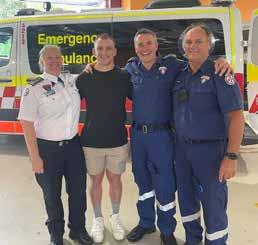
NSW Ambulance: Heartwarming Reunion
It’s been three months since intensive care paramedic David has seen 27-year-old Jack Di Tammaso, and Jack wasn’t in a good way last time they met. The 27-year- old had just suffered a stroke at his gym in Newcastle and intensive care paramedic David responded. Luckily for Jack a world-first trial was underway in the Hunter New England with NSW Ambulance paramedics using cutting-edge technology such as the Medfield Diagnostics Strokefinder MD100 helmet. Jack underwent a scan with the device in the back of the ambulance and was speaking to neurologists at John Hunter Hospital via video call in no time at all.
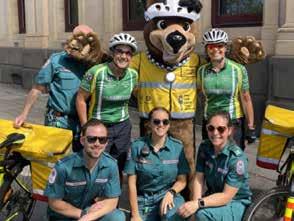
SA Ambulance Service: Tour Down Under
If you’ve been on the sidelines of the Tour Down Under, you might have seen SAAS vehicles and paramedics. The SA Ambulance Service team have two ambulances and a solo responder following the riders in case there are any crashes with injuries. They also have bicycle paramedics at the community events at the start and finish points, ready to respond quickly to medical emergencies in the crowd.

Queensland Ambulance Service: Paramedic Stu Teaches the Scouts
First Aid Skills
Pack it up, pack it in, let us begin, with paramedic Stu demonstrating some first aid skills to Victoria Point Cubs. The Cubs learned about the work of the paramedics and what to do if they were injured while ‘scouting’ about in the great outdoors, such as bandaging a wound or snakebite. After this demonstration, the scouts promised to “do their best” when helping someone in need.
#WomenInAmbulance #inthistogether #charitygolf #lovefromWA #WorldEnvironmentDay #bakeoff #stayathome #PeopleFIRST #SustainableAmbulance #HandHygiene #HandHygiene #NationalVolunteerWeek20 #restartaheart #restartaheart #MeFirst #WomenInAmbulance #inthistogether #dogsofambulance #lovefromWA #WorldEnvironmentDay #WorldEnvironmentDay #stayathome #StJohnDay #PeopleFIRST #HandHygiene #NationalVolunteerWeek20 #restartaheart #restartaheart #WomenInAmbulance #WomenInAmbulance #inthistogether #dogsofambulance #dogsofambulance #lovefromWA #lovefromWA #lovefromWA #WorldEnvironmentDay #stayathome #stayathome #StJohnDay #PeopleFIRST #PeopleFIRST #SustainableAmbulance #HandHygiene #HandHygiene #HandHygiene #HandHygiene #ThankAFirstResponder #NationalVolunteerWeek20 #MeFirst #MeFirst #MeFirst #inthistogether #dogsofambulance #charitygolf #charitygolf #charitygolf #WorldEnvironmentDay #WorldEnvironmentDay #WorldEnvironmentDay #bakeoff #stayathome #StJohnDay #StJohnDay #StJohnDay #StJohnDay #PeopleFIRST #SustainableAmbulance #ThankAFirstResponder #ThankAFirstResponder #restartaheart #restartaheart #restartaheart #restartaheart #restartaheart #MeFirst #MeFirst #WomenInAmbulance #WomenInAmbulance #WomenInAmbulance #dogsofambulance #dogsofambulance #charitygolf #bakeoff #bakeoff #bakeoff #bakeoff #stayathome #stayathome #stayathome #stayathome #stayathome #PeopleFIRST #ThankAFirstResponder #ThankAFirstResponder #ThankAFirstResponder #ThankAFirstResponder #ThankAFirstResponder #MeFirst #MeFirst #MeFirst #MeFirst #MeFirst #WomenInAmbulance #WomenInAmbulance #WomenInAmbulance #inthistogether #charitygolf #bakeoff #bakeoff #bakeoff #bakeoff #bakeoff #stayathome #stayathome #PeopleFIRST #ThankAFirstResponder #ThankAFirstResponder #ThankAFirstResponder #ThankAFirstResponder #ThankAFirstResponder #ThankAFirstResponder #ThankAFirstResponder #ThankAFirstResponder #NationalVolunteerWeek20 #NationalVolunteerWeek20 #NationalVolunteerWeek20 #MeFirst #MeFirst #MeFirst #MeFirst #WomenInAmbulance #WomenInAmbulance #WomenInAmbulance #WomenInAmbulance #WomenInAmbulance #inthistogether #charitygolf #WorldEnvironmentDay #WorldEnvironmentDay #WorldEnvironmentDay #WorldEnvironmentDay #bakeoff #bakeoff #bakeoff #bakeoff #bakeoff #stayathome #stayathome #stayathome #stayathome #stayathome #StJohnDay #StJohnDay #StJohnDay #StJohnDay #StJohnDay #StJohnDay #StJohnDay #StJohnDay #StJohnDay #StJohnDay #PeopleFIRST #PeopleFIRST #ThankAFirstResponder #ThankAFirstResponder #ThankAFirstResponder #ThankAFirstResponder #ThankAFirstResponder #ThankAFirstResponder
#ThankAFirstResponder
#ThankAFirstResponder #NationalVolunteerWeek20
#NationalVolunteerWeek20 #restartaheart #restartaheart #restartaheart
#MeFirst #MeFirst #MeFirst
#ThankAFirstResponder
#ThankAFirstResponder
#NationalVolunteerWeek20 #NationalVolunteerWeek20
#restartaheart #restartaheart
76 www.caa.net.au People First
Ambulance Tasmania: Emergency Service Workers go for Gold
There’s nothing like a bit of tug-of-war to get the competition heated 13 months out from the 2025 Australasian Police and Emergency Services Games – hosted in Tasmania. March 2025 will see approximately 3000 athletic emergency service workers competing in their chosen sport with around 50 sports expected to be on offer in Hobart. From football to running to playing golf, we hope plenty of Ambulance Tasmania staff and volunteers sign up to go for gold while also make new connections and have fun.
#MeFirst
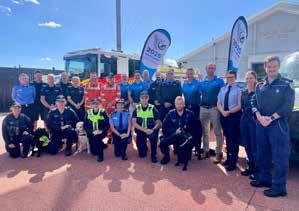
ACT Ambulance Service: A Motorcyclist’s Journey to Thank His Paramedic Hero
For our paramedics, helping the ACT community is a core part of the job –but they’re also grateful when someone takes the time to say thank you. James sustained a significant leg injury when he was involved in a motorcycle accident last year, and Sophie was the primary treating paramedic. Now six-months later, James arranged to meet Sophie to personally thank her for looking after him.
St John Ambulance NT: Who’s a Good Boy?
Parap Cadet’s were extremely grateful to have Senior Constable Ben Stove and Patrol Dog Cheeko give up some of their time to assist our cadets in achieving their “Caring for Animals” Junior Interest / Youth Proficiency Badge.
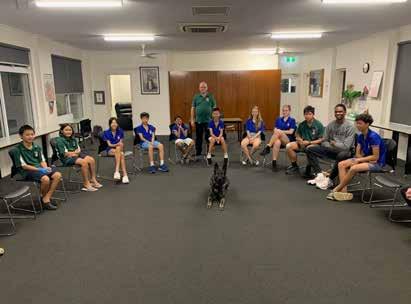

Hato Hone St John: Maggie – Dame of St John A royal seal of approval and big congratulations to Maggie who has become a Dame of St John. Maggie first joined Hato Hone St John in 1975 and has been an integral part of the West Coast community, managing ambulance stations, working as a transport officer, and serving on the local Area Committees. Her hard work has now been recognised by King Charles III who sanctions St John Honours as part of his role as Sovereign Head of the Order of St John.
“It’s overwhelming but exciting, especially being able to share it with my family, friends, colleagues and loved ones. I feel very blessed”, says Maggie.
Wellington Free Ambulance:
12/10
and a Round of a-Paws for all Pups and People
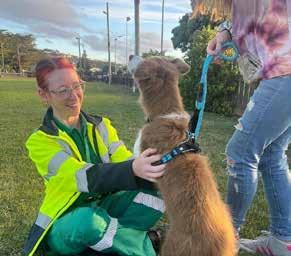
To pup-pare for adult life, puppies need to do plenty of meet ‘n greets - and Wellington Free staff were paws-itively excited to go along to recent Titahi Bay Canine Obedience Club training classes to lend a helping paw! By exposing puppies and young dogs to a range of people, especially those in uniform and fluorescent clothing, it can help them develop strategies to cope with new experiences later in life, helping them grow into calm, friendly dogs.
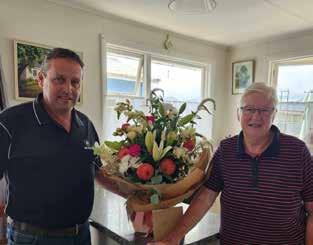
St John Ambulance Papua New Guinea: Training in Action
Ambulance officers in action during completing their annual reaccreditation training. All SJA ambulance officers, nurses, doctors nad paramedics are required to complete compulsory reaccreditation every 12 months. The training ensures they stay sharp on the vital skills needed to save lives.
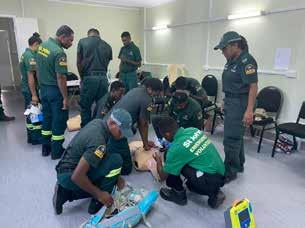
#dogsofambulance #charitygolf #charitygolf #bakeoff #StJohnDay #StJohnDay #SustainableAmbulance #HandHygiene #ThankAFirstResponder #NationalVolunteerWeek20 #NationalVolunteerWeek20 #restartaheart #restartaheart #MeFirst #WomenInAmbulance #inthistogether #dogsofambulance #dogsofambulance #bakeoff #stayathome #StJohnDay #PeopleFIRST #SustainableAmbulance #restartaheart #restartaheart #bakeoff #bakeoff #stayathome #PeopleFIRST #PeopleFIRST #HandHygiene #ThankAFirstResponder #NationalVolunteerWeek20 #restartaheart #MeFirst #dogsofambulance #dogsofambulance #charitygolf #charitygolf #charitygolf #lovefromWA #WorldEnvironmentDay #WorldEnvironmentDay #StJohnDay #StJohnDay #StJohnDay #SustainableAmbulance #HandHygiene #HandHygiene #ThankAFirstResponder #ThankAFirstResponder #ThankAFirstResponder #ThankAFirstResponder #ThankAFirstResponder #restartaheart #MeFirst #MeFirst #MeFirst #MeFirst #inthistogether #lovefromWA #WorldEnvironmentDay #bakeoff #bakeoff #bakeoff #bakeoff #stayathome #stayathome #stayathome #stayathome #stayathome #StJohnDay #SustainableAmbulance #HandHygiene #ThankAFirstResponder #ThankAFirstResponder #ThankAFirstResponder #ThankAFirstResponder #MeFirst #MeFirst #MeFirst #MeFirst #MeFirst #WomenInAmbulance #WomenInAmbulance #lovefromWA #WorldEnvironmentDay #WorldEnvironmentDay #WorldEnvironmentDay #WorldEnvironmentDay #bakeoff #bakeoff #bakeoff #stayathome #stayathome #stayathome #stayathome #stayathome #stayathome #SustainableAmbulance #SustainableAmbulance #HandHygiene #ThankAFirstResponder #ThankAFirstResponder #ThankAFirstResponder #ThankAFirstResponder #NationalVolunteerWeek20 #NationalVolunteerWeek20 #NationalVolunteerWeek20 #NationalVolunteerWeek20 #NationalVolunteerWeek20 #NationalVolunteerWeek20 #NationalVolunteerWeek20 #NationalVolunteerWeek20 #MeFirst #WomenInAmbulance #WomenInAmbulance #lovefromWA #WorldEnvironmentDay #WorldEnvironmentDay #WorldEnvironmentDay #WorldEnvironmentDay #bakeoff #bakeoff #bakeoff #bakeoff #stayathome #stayathome
#StJohnDay #StJohnDay #StJohnDay #StJohnDay #StJohnDay #SustainableAmbulance
#HandHygiene
#NationalVolunteerWeek20 #NationalVolunteerWeek20 #NationalVolunteerWeek20 #NationalVolunteerWeek20 #restartaheart #restartaheart #restartaheart #restartaheart #restartaheart #restartaheart #restartaheart
#stayathome
#SustainableAmbulance
#ThankAFirstResponder #ThankAFirstResponder #ThankAFirstResponder #NationalVolunteerWeek20
#MeFirst
77
CQU UNIVERSITY
With a vast footprint spanning Australia’s east to west coast and a digital one that’s global, CQUniversity Australia truly embodies our approach to education: we believe higher education should be for everyone. Our accessibility, flexibility, student support and wide range of courses available online and on campus help our students be what they want to be. Whether you’re looking to embark on a career in paramedic science or are already established and seeking your next challenge, CQUniversity’s career entry, career advancement and specialist study options in paramedicine can help you get there.
Learn More: cqu.edu.au
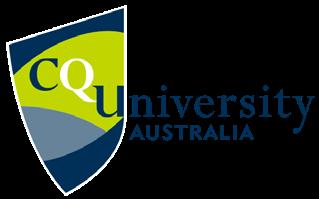
COUNTER-TERRORISM AND OPERATIONAL MEDICINE
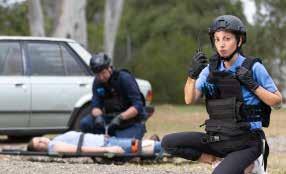
In situations involving acute trauma and prolonged field care, such as natural disasters and scenes of aggression and violence, the ability to operate appropriately can be a matter of life and death for more than those injured. CQU’s unique postgraduate courses in Counter-Terrorism and Operational Medicine (formerly Tactical Medicine) provide first responders, nurses, doctors and professionals similarly exposed to trauma medicine with a strong theoretical background and practical skills to successfully operate and manage patients within hostile environments. Our postgraduate courses are available entirely online.
Learn More: cqu.edu.au/study/counter-terrorismoperational-medicine
CAA helps provide an important link between the ambulance sector and businesses that provide goods and services for this industry. It’s instrumental in providing networking and partnering opportunities. Don’t hesitate to reach out to organisations of interest.
78 www.caa.net.au
DEDALUS
Dedalus Australia and New Zealand is part of Dedalus Group, the leading healthcare and diagnostic software provider in Europe, supporting the digital transformation of 7500 healthcare organisations and 5700 Diagnostic Centres worldwide, processing its solutions for a population of more than 540 million worldwide. Dedalus supports the whole continuum of care, offering open standards-based solutions serving each actor of the Healthcare Ecosystem to provide better care in a healthier planet.
Learn More: dedalus.com/anz/

AMPHI ELECTRONIC Pre-hospital RECORDED (EPCR) SOLUTION
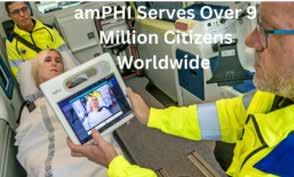
amPHI’s clinically driven Pre-hospital Record (ePCR) solution has been designed by ambulance clinicians to support the entire care pathway, from patient collection to hospital handover. Currently deployed in over 800 ambulance response units, including both road and air units, and utilised by over 15,000 concurrent users with a consistent uptime of more than 99.98%, this solution serves a substantial population of over nine million citizens.
The amPHI Solution components comprises of amPHI Mobile, amPHI Web, amPHI Special Events, amPHI Secondary Triage and amPHI Fleet Management modules. amPHI’s solution is not only secure, reliable, and resilient but is also scalable and configurable, to best support organisation need. Additionally, the solution offers powerful data mining and reporting opportunities, supporting clinical quality assurance and control monitoring and continuous improvement activities.
One of the notable strengths of amPHI’s solution is its ability to seamlessly transmit critical, real-time information between response units and receiving care facilities, fostering true collaborative care, and ensuring continuity of patient information throughout the care continuum.
amPHI - Informed and data empowered clinicians make the right decisions at the right time to support best patient care outcomes.
Learn More: dedalus.com/anz/our-offer/products/ amphi-pre-hospital/
Interested in becoming a part of The Directory? Contact admin@caa.net.au
79
HACKING Habit
Redesigning Your Systems for Effortless Self-Improvement

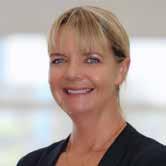 Mitch Mullooly Health and Wellness Strategist
Mitch Mullooly Health and Wellness Strategist
Specialising in the wellbeing of first responders, Mitch is Council member of Te Kaunihera Manapou, New Zealand Paramedic Council; Advisory Board member for Te Kiwi Maia, The Courageous Kiwi; and proud CAA2020 Women in Ambulance honour recipient.
Mitch is also a published author, speaker and feature columnist for several sector related magazines, blogs, webinars, and podcasts.
Wellness First
www.caa.net.au 80

We all have goals and ambitions that we strive toward, yet making tangible, lasting progress on those goals often feels frustratingly difficult.
Hands up those of us who have made bold resolutions to transform some area of our lives, only to see our willpower wane after a few weeks and our best-laid plans fall by the wayside. It’s not just me, right?!
Achieving major personal and professional goals through sheer grit alone is an uphill battle against human nature. After all, our brains are hardwired to conserve energy and prefer the path of least resistance, so maintaining heightened motivation and focus indefinitely is mentally taxing.
However, there is another way, a deceptively simple yet tremendously powerful approach that provides sustainable results while working in harmony with human behaviour rather than against it. That way is the philosophy of “atomic habits” pioneered by author James Clear.
The key insight behind atomic habits is that small, incremental daily routines propel us toward our goals through the accumulation of tiny victories, choreographed precisely through the power of habit formation. By reframing our ambitions and focusing not on the result we crave, but on the habits and systems that fuel consistent progress, we can radically reshape our lives in a sustainable fashion.
What Are Atomic Habits?
While most people chase goals directly through willpower and motivation, Clear’s core principle is to redefine the inputs rather than prizing the outputs. Instead of an all-consuming obsession about losing 10 kilos, writing an amazing research application, or blitzing that next pathophysiology exam, Clear urges us to concentrate on the daily behaviours, rituals and routines that will ultimately lead to those outcomes over time.
Most important goals require not just a short-term sprint, but the development of small, repeatable habits stretched over a marathon journey of months, years or even decades. This aligns with the notion that we don’t actually rise to our goals, but to the level of our systems.
The magic of atomic habits stems from the accumulation of many small, low-stakes choices over time that compound into massive, life-altering results through the physics of time and consistency. Each “atomic” habit, be it going to the gym for 10 minutes, doing 10 minutes of focused work on a goal, or simple changes like drinking a glass of water after waking up, seems trivially easy in isolation. But those tiny individual wins accumulate into major progress over weeks, months, and years through the power of habit formation.
81
Wellness First

Why Small Habits > Dramatic Change
One might reasonably question whether a slew of tiny habits can really lead to dramatic, exciting life changes. But going small offers three key advantages over the conventional approach:
1. Sustainability: Attempting an immediate, drastic overhaul in multiple areas of your life at once inevitably creates overwhelm, fatigue, and a rebound to old patterns as our limited motivational reserves get drained. But small, easy habits embedded into our daily routines bypass motivation through the power of reinforced behaviours. Over time, habits become essentially self-reinforcing.
2. Compounding: All big things come from small beginnings. Every habit repeated enough times amplifies results through the multiplicative power of compounding interest. For example, saving a dollar a day at 8% interest yields over $1 million after 65 years. The impact of tiny marginal habits is exponential, not linear. An attitude of “continuous improvement” wins.
3. Identity Change: As we consistently practice small daily habits aligned with our goals over months and years, those behaviours become part of our sense of identity. Identity precedes action. If you continually reinforce the identity of an athlete or health-conscious person, eating well and training become natural reflections of who you believe you are. When habits are ingrained as intrinsic traits rather than forced behaviours, motivation is no longer required.
Making Habits Stick
While the power of tiny habits is profound if consistently implemented, the crucial challenge is making those small behaviours stick as ingrained routines. In Atomic Habits, Clear outlines a powerful framework for designing habits that turn everyday systems and processes into a selfperpetuating cycle.
The core idea is to code desirable habits into frequent situational cues based on your current routines, then used reinforcement and tracking tools to create a satisfying feedback loop that encourages the habit to stick and compound over time.
The goal is to make habits obvious, attractive, easy, and satisfying:
Obvious: We cannot uproot bad habits until we are aware they exist. Identifying cues and triggers for when and where you want habits to occur is key to making habits instinctive and automatic over time. Ideas like implementation intentions (“I will [HABIT] at [TIME] in [LOCATION].”) and habit stacking (“After [CURRENT HABIT], I will [NEW HABIT].”) are very useful here.
Attractive: We need reasons to not just start habits but stay motivated to continue them long-term. Inserting immediate enjoyments like temptation bundling (combining habits you want to build with habits you already enjoy), joining a culture where desired behaviours are the norm, and using visual motivators can increase habits’ emotional allure.
Easy: Good habits need to be convenient to do and bad habits inconvenient to not do. The principal strategy is to reduce friction as much as possible through systems like the two-minute rule (cultivating a “gateway” habit around the very first few reps which leads to the full habit), environment design (e.g. putting your gym clothes right next to your bed), and habit stacking onto already existing routines.
Satisfying: We are more likely to repeat a behaviour when timing and delivering a prompt reward in a quick feedback loop. Using visual habit trackers, applying small pleasurable rewards, and personal self-accountability strategies like journaling help close the loop and solidify habits through satisfaction and reflection.
www.caa.net.au 82
The Ripple Effect
Consistently working atomic habits through the framework above leads to a powerful wave of improvement that permeates every area of life. Each positive habit sets off a domino effect, creating an upward spiral that impacts far more than the habit itself.
For instance, starting a daily 3km walk does more than just improve physical fitness and endurance. Thanks to the mental reset and psychological break during the walk, you may notice yourself feeling more clear-headed, productive, and focused. You may have more inspiration for hobbies, interests, and intellectual pursuits. Confidence and optimism from exercise often inspire self-disciplined choices regarding other habits like nutrition, sleep, and stress management. Eventually, your very identity evolves into someone who values health as a core priority and virtue.
Success breeds success. When one small daily discipline takes root, it kickstarts selfefficacy and motivation to take on new challenges and habits. As you start to “feel” differently through a series of small, sustained choices, you fundamentally rewire your character and mindset.
We are what we repeatedly do. Excellence, then, is not an act, but a habit.”
Aristotle

Over time, the sum total of many small habits properly wired eventually leads to profound transformations, not just in goal achievement but in the overall person we become. The tiny ripple of an initial routine or two amplifies into a tidal wave of positive change that impacts confidence, mindset, health, relationships, career and ultimately every aspect of life experience.
By mastering the art of making tiny, easy habits inevitable, we escape the chains of relying on sheer willpower, motivation, and chaotic life changes. By working smarter, not necessarily harder, we unlock our fullest potential through the power of atomic habits.
Follow us on Facebook CouncilofAmbulanceAuthorities
Find us on Twitter @CAAAustralasia
Connect with us on LinkedIn council-of-ambulance-authorities-australasia
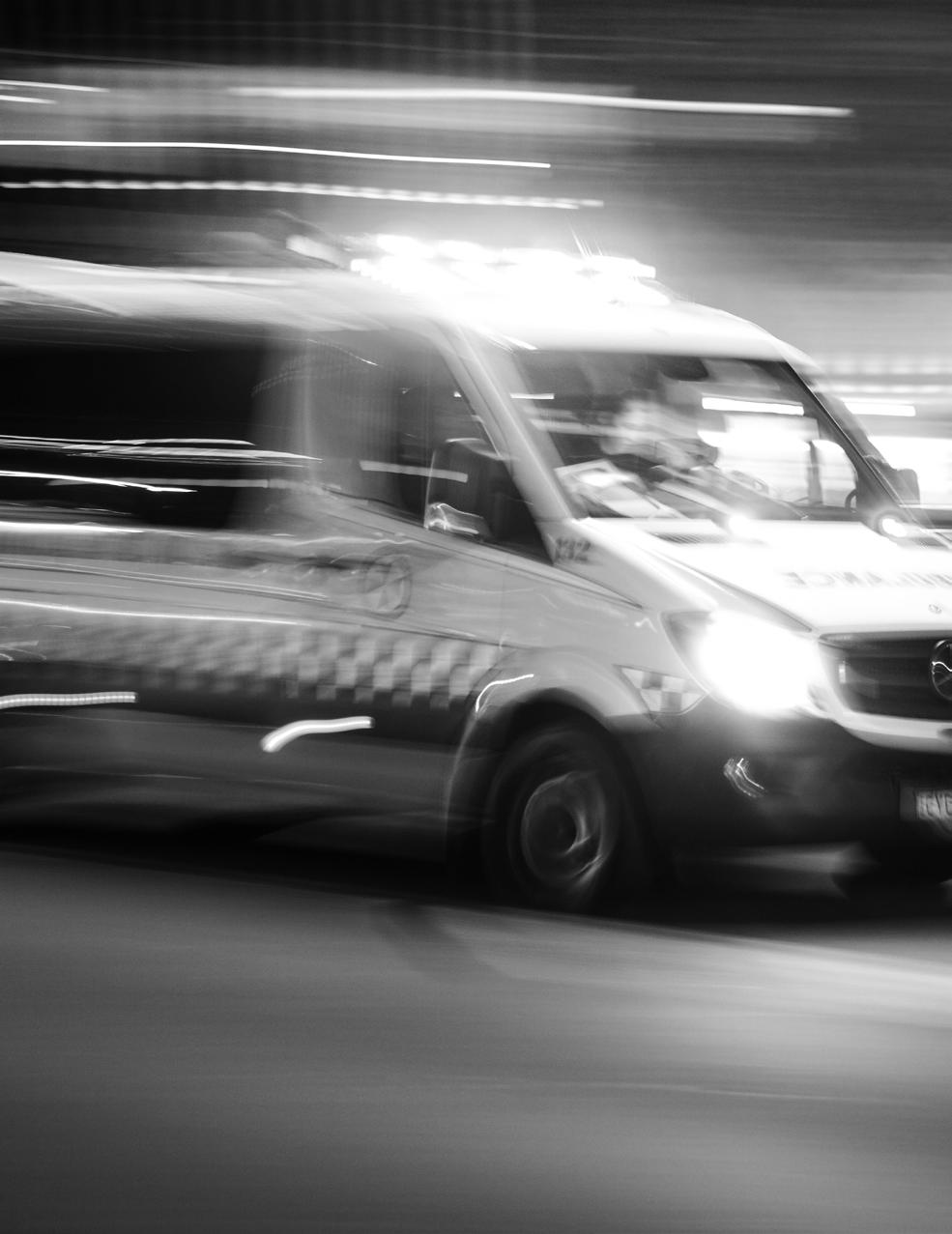
For information on other CAA activities please visit








 Mojca Bizjak-Mikic Editor-in-Chief FIRST magazine
Mojca Bizjak-Mikic Editor-in-Chief FIRST magazine





















 Howard Wren
CAA Chair and Chief Officer for the ACT Ambulance Service
Howard Wren
CAA Chair and Chief Officer for the ACT Ambulance Service








































































































































































 Mitch Mullooly Health and Wellness Strategist
Mitch Mullooly Health and Wellness Strategist



